#punk New York supremacy
Explore tagged Tumblr posts
Text
i can see New York looking like these three options:
1) a dedicated father with a short black mullet
2) a man who hides his buzz with his beanie
3) 300 million piercings with bleached spikes
I cannot see him any other way
#wttt#wttsh#welcome to the statehouse#wttt new york#wttsh new york#wttsh headcanons#wttt headcanons#wttt fandom#draw New York with spikes pls#he would looks so cool#he would look like a mace#punk New York supremacy#💪💪
31 notes
·
View notes
Text
Really long headcanon post for the stuff that I’ve posted on Wattpad :3
Massachusetts:
-Mans is my height, 5'6, and he hates being bullied about being the shortest of his brothers lmao
-Is twins with New Jersey, though Jersey makes fun of him cuz he's five minutes younger
-he has reddish brown shoulder-length wavy hair and hazel eyes
-mf is built like the Dwayne Johnson though he's just missing the height
-TRANSMASC MASS SUPREMACY 🛐🛐
-this man acts all tough until the cramps come along. Then he's dead.
-doctor of the statehouse, along with Texas. He deals with sickness/illness whilst Texas deals with injuries. Though he can do both cuz we love that.
-tried learning how to make flower crowns cuz NY would always make them for everyone when they were younger. He tried his best, and he's actually kinda okay at it, so him and any will just hang out and make flower crowns.
-^he has put a spell on every single flower crown that he's ever given or received so that they never shrivel up and die
-OCD, autism, and ADHD
-loves rock, metal, and punk music. Especially FFDP (THEY HAVE NO BUSINESS BEING THAT FRICKIN' GOOD LIKE WHAT-)
-friends with the OG13 (no dip Sherlock-), Maine, Texas, and Louisiana.
-REFUSES TO ADMIT HE HAS A SOFT SPOT FOR NEW YORK. EVEN IF HE'S ACTIVELY HUGGING HIM. HE WILL DENY IT TILL THE DAY HE DIES. HE WILL DO ANYTHING FOR THIS DAMN KID.
-^the moment he met New York, he was filled with the urge to take him away from England immediately. He does pick favorite brothers btw. And it's New York.
-sharp lil canines like he's a friggin vampire smh
Sippi:
-he is a squishy boy and we love that <3 it just makes him better for cuddling
-he's not short, not tall, he's only 5'8.
-he's a pathetic loser tbh but we still love him
-sippi loves stuffed animals, but his favorite is a teddy bear that was given to him by New York (fun fact, teddy bears were invented in Brooklyn, and were named after the president that refused to shoot a bear!).
-he named it Mr. Cuddles, and it is the most beat up stuffed animal that he owns (as in, its ear had to be sewn back on, one of its eyes has been replaced by a button, and it has random stitches and patches all over) but he still loves it and cherishes it to this day.
-friends with (omg he has friends????) Texas, Louisiana, Florida, New York, South Carolina and Georgia
-yes yes he is but a cuddly marshmallow. Until you hurt someone he loves. Then you're dead.
-he SCREAMS whenever there's a bug. Strangely though, he likes ants, moths, and butterflies.
-mans is colorblind
-he doesn't like his squishy-ness and has tried to starve himself on numerous occasions :(
-I think that the fact that he's been owned by 3 different countries is grounds to give him abandonment issues right? Okay.
-if it weren't for his friends just simply existing, he would've been long gone by now. (same tho- I mean what?)
-I'm not gonna say he's hurt himself before, but I'm not gonna say he hasn't either 👁️👁️
-bro thinks that anybody he gets close to is gonna leave him :[
-if he gets hurt, he's not gonna bother telling anyone cuz he doesn't wanna feel like a failure for not being able to defend himself
Texas:
-this man is T A L L- he's 6'5 (not as tall as Alaska though so HA-)
-I imagine him to be very slim and fit, but he has a tiny bit of pudge around his lower stomach and hips and thighs.
-he LOVES animals so, so much. More than humans tbh.
-he has a horse (Ranger), 5 dogs (Rosco, Daisy, Cassy, Billie, and Maria. Rosco and Cassy are German Shepherds, Daisy and Billie are heelers, and Maria is a demonic chihuahua), 3 cats (Mittens, Sassy, and Milo), and 2 snakes (Spot and Harvey).
-^thats just at the statehouse. Back home, he has an animal sanctuary where he takes care of animals, takes them in, nurses them back to health, ect... It's very adorable and I love it.
-speaking of animals, he cannot, I repeat, CANNOT keep it together if an animal dies or gets hurt in a movie. Homeward Bound? Mans was not okay. Hachi? He wasn't ballin', he was bawling 😔.
-I BELIEVE IN TRANSMASC TEXAS SUPREMACY 🛐
-he still wears a binder cuz he doesn't trust the doctors to perform top surgery on him.
-ADHD for DAYS- don't give him an energy drink unless you want a 6'5 chihuahua on cocaine to be following you around.
-ADHD, autism, ocd, depression, anxiety, and ptsd. Idk if daddy issues counts, but he has those for sure.
-this bitch has fallen off of so many things that he no longer takes fall damage
-Mexico was such an asshole to poor Texas...... I wanna skin him alive :)
-Texas CANNOT handle someone raising their hand or voice at him. He can't. He will flinch and/or cry. Which he hates. Cuz he's supposed to have this reputation as the big strong Lone Star State.
-he has SH scars on his wrists, sides, and thighs. They vary from blade marks, to cigarette burns, to even scratches.
-he hates all of his scars so, so much and sees them as nothing but a sign of his weakness and inability to defend himself.
-Texas is also kinda insecure about the little bit of pudge on his lower belly, hips, and thighs. What makes it worse is that he can't really help it. Especially the stomach pudge cuz that's just where his uterus is. Does he know this? Yes. Is he still insecure? Yes.
-he often binds too long or forgets that he has his binder on until it's too late and there is severe bruising and even minor bleeding underneath the band. Along with breathing difficulties.
-^to make the breathing difficulties thing worse, he has asthma :)
——————
#welcome to the table#welcome to the statehouse#ben brainard#wttt#wttsh#wttt massachusetts#wttsh massachusetts#wttt mississippi#wttsh mississippi#wttt texas#wttsh texas
21 notes
·
View notes
Text
head full of emo dc thoughts....
sorry in advance for the word vomit, this post is just a brain dump while i doodle him
so the history of emo is actually pretty neat. iirc the genre started in dc in the 80s with "emotional hardcore" punk that had more emotional lyrics than regular hardcore punk. the name eventually got shortened to "emocore," and later, "emo."
and like. punk came from ny, so i think when dc was first getting into the emo scene he dressed a lot like new york? but a little more toned down. less spikes and patches on his clothes, more rips and worn spots.
then moving into the late 90s and 00s as emo became more of a developed thing, dc started dressing a little more out there. fingerless gloves studded belts fishnets under his tshirts and chains wherever he could. started growing out and straightening his hair too :] emo fringe dc supremacy (his hair was so greasy too during this period. babygirl did Not shower)
one of my personal hcs is that dc absolutely loves cherry blossoms, and i'd like to think he always tried to sneak them into his outfits. just a little doodle on his shoes or a charm on a bracelet or something. theres always at Least one somewhere on him
im gonna draw him soon istg but like. i need Someone to go as crazy go stupid as i am rn. Please understand
#he is such a weird little wet rat to me <3#points at him. Greasy#maybe eventually i'll go into midwest emo and which states have influences from that#Maybe.#welcome to the table#wttt#wttt district#wttt dc#ghostie's posties
27 notes
·
View notes
Text
Recommending Albums 1 & 2
So technically, calling this either "Recommending Albums 1" or "Recommending Albums 2" is wrong, because my recommendation of In the Aeroplane Over the Sea was called “Recommending Video Essays #8” because I didn't know if I was ever gonna recommend another album, especially so soon. However, it's still the first instance of "Recommending Albums" as a title. So what I'm gonna do is cheat and just say that this is 1 & 2.
Recommendation 1 can be found here.
Recommendation:
The Holy Bible 20 – Manic Street Preachers
The Holy Bible 20 (or just The Holy Bible) is an album that I haven't ever really heard many people talk about. To me this is shocking, and to the annoying RateYourMusic dweller part of me, is just downright unacceptable. It also may not be that shocking in reality.
The Holy Bible came out in 1994, a single year filled with so many unbelievably influential and important albums like Illmatic by Nas, Dummy by Portishead, The Downward Spiral by Nine Inch Nails, Grace by Jeff Buckley, Ready to Die by The Notorious B.I.G., Weezer's self-titled Blue Album, Superunknown by Soundgarden, MTV Unplugged in New York by Nirvana, and Diary by Sunny Day Real Estate. In the years before 1994 (most notably for me), My Bloody Valentine's Loveless (1991) became the singular Shoegaze album, A Tribe Called Quest's Low End Theory (1991) largely dictated what Hip-Hop would sound like for the coming decades, and Nirvana would inform the world about Seattle grunge rock with Nevermind (1991) and In Utero (1993). This train of revolutionary albums chugged through to the end of the 20th century as well with Radiohead's The Bends (1995) and Ok Computer (1997), Outkast's ATLiens (1996) and Aquemini (1998), Elliot Smith's Either/Or (1997), Lauryn Hill's The Miseducation of Lauryn Hill (1998), Neutral Milk Hotel's In the Aeroplane Over the Sea (1998), etc. This single decade spawned so many of the most recognizable, popular, and highest rated albums of all time, so to be drowned out among the all time greats is maybe to be expected.
But, The Holy Bible 20 should absolutely be one of these recognizable classics, and absolutely deserves to be talked about as much as Rage Against the Machine's self titled debut or Nine Inch Nails' The Downward Spiral.
The mention of these albums specifically are of particular interest for comparison as they share a lot with The Holy Bible. Rage Against the Machine is a really easy comparison to make. They're pretty similar sounding albums, although Rage Against the Machine lays way more into the metal side of Punk Rock. The Holy Bible has some really catchy riffs both in the lead guitar and bass and is just as head-bang-able as any good Punk Rock album should be. It's instruments are more often than not really clear and bright for the genre, only using heavy distortion and loud, complex sound for the choruses of songs where the energy goes way up. It's never cheery, but it definitely reflects the bands British origins. James Bradfield's voice very clearly and sharply cuts through the instrumentals when he sings and gives the most to the album's shockingly clean sound.
Both of these albums go through song-by-song, serving almost as revolutionary crys for the disgruntled group of mostly suburban high-school aged kids in the nineties who sees the flaws and cruelties of modern capitalist society and wants change. Largely aiming at the most relevant target around for this, white America and the institutions they created, the albums (in the most simple reading) go “Fuck off, I see what you're doing here and how you marginalize people. Die.” For Rage Against the Machine this most notably comes in the form of comparing the hardcore right wing accelerationists like the KKK and contemporary neo-nazi movements and modern police forces and the people who work for them, and the racial injustices spawned out of the idea of white supremacy. The album is also a call to arms to take back power for the people. “We gotta take the power back!” For The Holy Bible it's drawing the comparison between modern (for the nineties) gender politics and the systematic marginalization of anyone considered other, and a telling of how the constant re-enforcement of the “normal” affects those considered abnormal. The Holy Bible takes a more poetic approach to the overall presentation of the message compared to Rage Against the Machine, which is mostly just a really banging call to arms.
Potential Content Warning for Suicide and Self-Harm
While this an accurate summary to The Holy Bible 20 it misses the some of the finer points of the album that allowed me to make the kind of pretentious sounding comparison to Nine Inch Nails' The Downward Spiral; an album largely about Trent Reznor's declining mental state in the face of a society who seems content with eating itself alive to keep in it's direction. The Holy Bible 20 was mostly written by Richey Edwards, who served not as the bands vocalist or a player of the instrumentals, but as the band's spokesperson and main lyricist along with the band's bassist Nicky Wire. I don't know a lot about Richey, but what I do know is that Richey was very open about having pretty severe depression and self-harm issues in interviews and from what I understand had an issue with alcohol abuse. Richey has been a missing person, since February 1, 1995, and has been legally presumed dead since 2008.
While a lot of songs can be read as, and are, really powerful critiques of how the systems of power in today's society marginalize anyone deemed unfit to be the normal, the perspective of a lot of what the album is about changes when you know that most of it was written from the perspective of someone who was really struggling with themselves mentally and would go missing 6 months after the album was released. It's not just an example of how these injustices and hardships can hurt and negatively shape and mold people into broken people, it's a first hand account. This makes a lot of the lyrics on the album even more sad and tragic than they already apparently are, and adds a new context to the entire album.
The first track “Yes” is a critique of the mind set consumerism creates for both the rich and poor, but with knowing what Richey went through, the account of the emptiness of depression starts showing through. “She is Suffering” and “4st 7lb” transforms the the messages about beauty standards into really haunting accounts of problems with self-image and self-worth. This in my opinion is what really makes this album special. It is a biting, unrelenting, extremely blunt critique of the system that disregards and hurts people for the feeling a uniform feeling of normalcy that anyone can pick-up and understand that is formed and shaped around a hidden perspective of someone that can't seem to help themselves. It's really sad, really haunting, and all of it is put over some of the most catchy riffs of the 90's.
The music is great, and really makes me feel like a kid from suburban Illinois in 1996 who really hates going to church, but what it has to say both on the surface and the more sub-textual accounts is what really makes this worth listening to.
It's one of my absolute favorite albums of all time. 10/10.
Other Recommendations:
I just talked about them a little bit, but both Rage Against the Machine (1992) and Nine Inch Nails' The Downward Spiral (1994) are really worth listening to if you even just like music. I personally like The Downward Spiral more because of how unique it still sounds to this day, so if you can only listen to just one I would pick that one.
But don't pick just one. Listen to them both. Please listen to them both. Please. Okay thank you bye <3
#manic street preachers#the holy bible#the holy bible 20#recommendations#album review#the downward spiral#rage against the machine#please tell me if there are any errors in my writing thanks <3
2 notes
·
View notes
Note
hiiii <3 big ask big answer is what i'm expecting would LOVE to know your top 5/faves across various media that are new(in release or just new to you) this year! so: shows, movies, games, books, songs/albums, new artists you've discovered etc
hi!!! you don't know how excited i got to see this pop up in my inbox, i love talking about things i love so thank you <333 i hope you don't mind that this will be super long lol 😭
shows severance - okay so i have to start off with severance because it is THE BEST show i saw this year, i've begged everyone i know to watch it. i encourage you to watch it if you haven't! it has such an exciting premise (what if you have no recollection of who you are at work, and the work version of yourself has no idea who you are outside of work, and you had to reconcile those two people?) it's such a juicy concept that explores the way jobs take advantage of workers, in an amazing sci-fi setting. also from a totally nerdy perspective, the retro-futurist aesthetic of it is amazing like the set designers really created an immaculate setting. it's a great story of found family, it has mystery, it has twists. i watched it twice all the way through! when i finished it the first time i was in despair at the thought of having to wait for its second season.
andor - euuugh i hesitate to put a star wars show here because as much as i love star wars, the shows for the most part suck so bad. but i loved andor so so much. i was genuinely surprised week to week at how every single episode was crafted beautifully and kept me engaged. i was pleased at how unapologetically it holds a mirror to the evils of fascism and white supremacy and colonization. it's definitely not without its flaws but as a star wars fans it's everything that star wars should be. it's so clear that the people involved in its creation are passionate about the story they're telling.
and in an attempt to not make you read an essay about every show i liked, some other faves were: interview with the vampire and ted lasso, and technically not new to me this year but i have to say succession my forever love <3
movies nope - i love horror, i love movies, i am so scared of aliens lol. this movie was so amazing for so many reasons. but among one of my biggest reasons for loving nope is that it feels like the kind of movie only someone who loves movies can make. it's so clear jordan peele loves movies, and so much about nope feels like a love letter to the making of movies, which i'm sure is a weird takeaway but it was one of my takeaways regardless. the story, acting, sound design were fantastic. i had so much fun watching it.
everything, everywhere, all at once - there's so much to say about this one. i love when the whole point is that yes, we are just stupid little humans trying to connect. i love reckless optimism. as someone with immigrant parents, a lot resonated with me. and the visuals were incredible. i love that it's goofy and over the top and poignant and that it balances all those things so beautifully.
meet me in the bathroom - i love documentaries!!! and music so much! this was such a fun look at the explosion of rock music in new york city during the early aughts. it's the kind of movie that makes you want to convince your friends to start a terrible punk band with you immediately after watching.
other faves: thoroughbreds, street gang: how we got to sesame street, and lake mungo (a slow-burn documentary style horror movie that genuinely freaked me out, and i don't scare easy!)
games i didn't really play many new games this year, mostly just revisited some old ones. but i have to insist that disco elysium is the best game i've played in recent memory. i played it for the first time last year. it's brilliant. the writing is incredible, the characters are incredible, the voice acting is incredible. i would try to explain what makes it so great, but it really is the kind of thing you have to experience for yourself. and i highly encourage you do!
books i feel like i read so many great books this year among them: the only good indians by stephen graham jones - a group of friends are haunted by a mistake they made in their youth. it's great psychological horror and commentary on the native american experience
crying in h-mart by michelle zauner - michelle zauner's memoir on reconnecting with her culture after her mother's death. it also gives really great insight on japanese breakfast's discography. it made me cry a ton!
the final revival of opal and nev by dawnie walton - a fictional oral history of a black punk rock musician. it's fun, it's emotional, the writing is great and the characters really suck you in. i think it's also a great read if you're someone who's into music
lost boy by christina henry - this one shocked me with how much i ended up liking it. it's an imagining of captain hook's origin story, which didn't sound initially appealing to me, but it was so beautifully written, devastating, and even horrific at times. the affection that jamie (who becomes captain hook) has for the other lost boys is just really tender and sweet. this is one of the most recent books i read this year and it quickly became one of my favorites!
music
you've been reading for so long now, i'll try to keep this concise:
songs: mujeres by y la bamba (i only heard this song for the first time a few months ago and it got to my 8th spot on my spotify wrapped!! the drums are incredible, the lyrics are fun, i just love listening to it) la combi versace by rosalia, pattern doubt by young jesus, hertz by amyl and the sniffers, good times by genesis owusu, back to oz by sufjan stevens, should've been me by mitski, and so so so many more
albums: in the aeroplane over the sea by neutral milk hotel, fever to tell by yeah yeah yeahs, laurel hell by mitski, jubilee by japanese breakfast, sable by japanese breakfast (i don't think i ever listened to this album all the way through but the first couple of songs are perfect to listen to while i'm working on writing)
#okay sorry to put you through this essay lol#but thank you for asking <3#i'd love to hear from you about your faves this year#this was fun!!!!#also fun fact i also follow you from my simblr lmao#cheesehair#val talks
5 notes
·
View notes
Text
k so i wanna engage in Smart People Discussions as a Real Adult and this made me realize I need to Know Some Things in life, so if anyone can help me out with any of the following because idk how I'm gonna tackle everything I want to learn before i die :
- The Bosnian Conflict
- how do companies/corporations/whatever ACTUALLY work
- Like I know the media can't be trusted but like... how?? like what is actually wrong with reading a New York Times article and believing every word?
- also explain exactly WHY Amazon is bad, cause I know it is
- look into white supremacy in local police precincts and the FBI's knowledge of this
- Shakespeare's bisexuality??
- Thomas Day on the Declaration of Independence's hypocrisy (condemnation of slavery in slavery's day)
- Olive oil's use as lube for gay sex in Ancient Greece??
- how the Salvation Army works/how they're bad
- are there any benefits of watching a certain movie just because the protagonist is a woman/black person/ etc. Idk, even if it just normalizes those people in those roles in my brain?
- how free healthcare works (in Canada). Is it actually free? Do we just pay for it in our taxes or something?
- when I was little I specifically remember being told the Black Panthers were terrorists, but now I'm reading that they were a civil rights group/ activists??
- origin of the statue of liberty
- how was Christopher Columbus actually viewed in his day
- gay people (pink triangles) were kept in concentration camps after liberation ("Paragraph 175")? did the Allies do this on purpose after they liberated everyone else??
- US bombing of Laos
- India's culture pre-colonization (tolerance of homosexuality?)
- Elon Musk sending an un-sterilized vehicle into space and that this is dangerous
- That there has never actually been a country that was properly communist so we can't say that we know communism doesn't work
- Us vs Nicaragua??
- Origins of AAVE and its validity as a dialect/vernacular
- Joan Trumpauer Mulholland
- Hobby-Lobby Iraq-US museum scandal...
- criminalization of black people via criminalization of weed... was this deliberate from the start? what was the war on drugs and how does this tie into it
- punk subculture, riot girl (grrl?), radical feminism
- what exactly is Two-Spirit and its history and validity in Indigenous cultures
- history of the recognition of the gender non-binary/ gender freedom through the centuries
- how do i learn enough about how the economy works to form an opinion on the best economic system (cause i know i'm anti-capitalist but like how exactly do i support that)
- is it possibly to save the planet at this point? or even just delay the inevitable? if it were, is it possibly to get people to actually do it?
- use of overcomplicated language to make info less accessible (see my previous post quoting Gloria Steinem
- what complete destigmatization of menstruation would look like. more specifically, why we need it because sometimes i just think it should be on the same level as other bathroom things (like we don't talk about pooping in public because... it's gross) but sometimes i recognize that it's about so much more than that because it's not just another bathroom thing, it ties into traditions of misogyny, oppression, etc.?? am i on the right track here...
- why prison doesn't work
- but first maybe, what exactly is the prison system
- how exactly do gangs work (i read the Freedom Writers Diary okay)
- how do Canada's levels of government and judicial systems work
- Mexico's refusal to accept a fugitive slave treaty with the US
- do universities really need to be that expensive? if not, why are they? are those in charge of them really just making billions from them then?
- Mexican Revolutionary war
- the male vs female gaze
- where do our current beauty standards come from
- use of propaganda in north america in the 21st century
- that photo of 2 covers of the same issue of the wall street journal that are different because of the different demographics of the areas they're sold in/marketed to.
- Toys R Us US corporation vs Swedish union 1995
- Tovegene Khatun
- why do we have different skin colors/where does melanin come from and why? geography?
- the watergate scandal
- are there actually more gay/autistic/depressed/u name it people now adays than in centuries past? or are they just actually diagnosed now?
- brand identity scheme- companies' social media accounts presenting as relatable people in their advertising
- museum collectors stealing Idigenous artefacts, saying their origins are "unknown"
- pol pot and khmer rouge in Cambodia
- what was happing in Cambodia in the '90's (basically why were there refugees? was there a war?)
- origins of witches and witch hunts (before Salem...?)
- fall of rome
- spanish inquisition
- idi amin of uganda
- leopold 2nd of belgium/ the congo
- armenian genocide
- that yale study about women's pain being perceived as less serious than men's
- are there still people today living in southern usa who think that slavery was a good thing and with they were still in the "good old days"?
- did c sections really originate in uganda/tanzania/the congo??
- how does money actually work (why we can't just "print more")
- how does inflation work (couldn't we just... leave prices where they are? is it because as natural resources get scarcer, they get more expensive?)
- is abolishing the police ever actually going to happen and how would we go about doing that. what does it really mean/look like?
- was the irish potato famine actually deliberately caused by the british? why?? also how did it even start. and did Choctaw Native Americans actually send aid?... how?
- seneca village in central park nyc
- russian meddling in the 2016 US election?? Reality Leigh Winner
- How Finland ended homelessness
- the Haiti Revolution 1791
- how hawaii became a state. idk i just heard it was bad
- che guevara
- Tulsa race massacre and Tulsa's black businesses before it
- the only coup d'état in America; The Wilmington insurrection of 1898
- body positivity is the kind of movement that I can totally recognize is a good thing and will get behind, but I have a question... isn't being overweight unhealthy? Or is it only healthy if you're like "dangerously obese"? Or, is body positivity not denying that you're unhealthy but about loving yourself anyway, while you do or don't work on becoming healthier? Or is just about how it's nobody's business to shame your body's appearance, healthy or not?
- complexities of the Anita Hill-Clarence Thomas case and verdict.
-SNC Lavalin Affair
Have at 'er my friends, any info I can get. And preferably sources too, cause Pinterest is helpful but I gotta read exact facts myself, can't take anything at face value.
#queer#bisexual#che guevara#hawaii#history#gay history#non binary#non binary history#two spirit#indigenous#russian#russia#reality winner#reality Leigh winner#finland#homelessness#haitian#haitienne#haiti revolution#1791#2016 election#irish potato famine#british history#british monarchy#seneca#seneca village#central park#nyc#choctaw#abolish the cops
16 notes
·
View notes
Text
Paris Haute Couture Week S/S 2020 Plus a Little Jacquemus: Okay, Dior DID Suck (Part 2/2)
Hi to anyone reading,
First of all, thank you! I have never had a post do as well as the part 1 of my haute couture week review did and I am so overwhelmed with the positive feedback. This is probably funny to read for those of you getting thousands of reblogs on your posts, me acting like I won an academy award because I got a couple of hundred, but honestly I don’t expect any traction when I write on here (it’s basically just me word vomiting everything I’m thinking as if people want to hear it aka. mouthing off into what I thought was the void) so if you did read it, thank you! I do spend a long-ass time on these so it means a lot:-)
I’ll leave the self-indulgent ramble there though as it’s probably not what you came for and jump straight into part 2 of my thoughts, starting with Jacquemus. Yeah, I knew what I was doing when I tagged that in my last post. Simon Porte Jacquemus is the man of the *fashion* people right now; I’ve even found myself coming round to the Le Chiquito bag despite my original thought being “well, that’s fucking useless”. I know, I know, technically it’s not haute couture; it was part of Men’s Fashion Week, but it happened around the same time and everyone was talking about it on Twitter, so I feel like I have to include it.
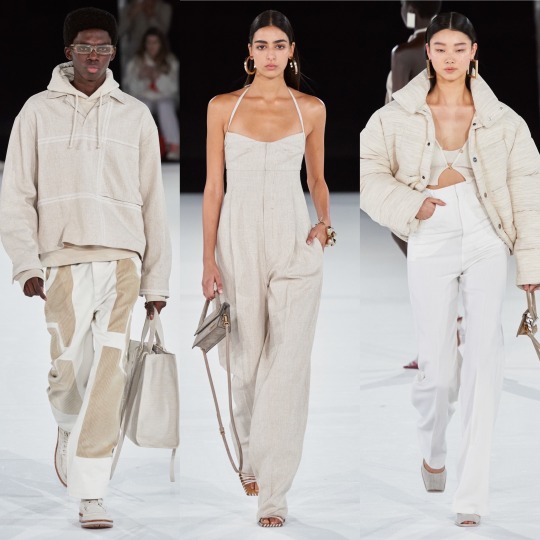
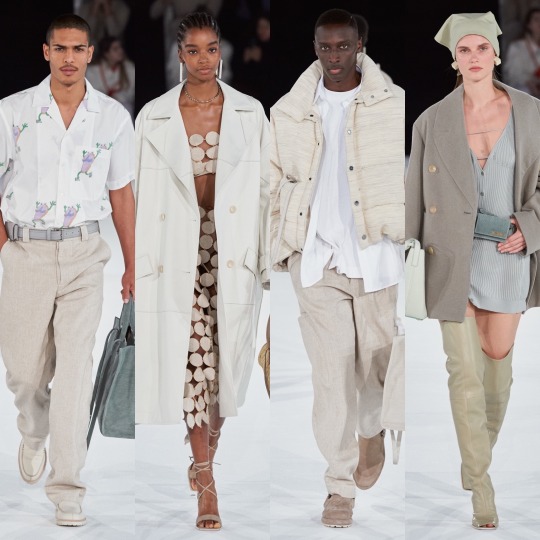

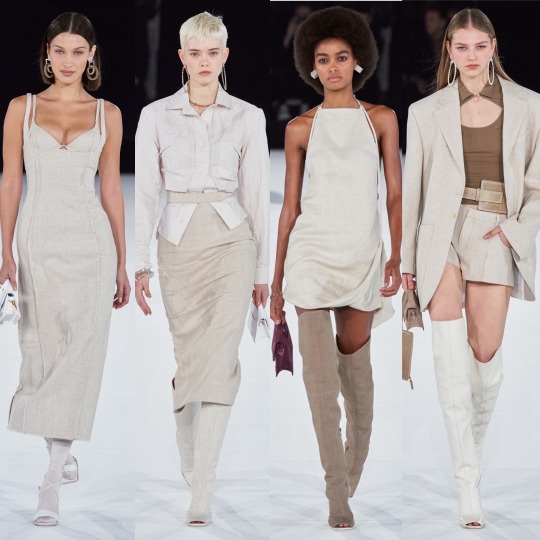

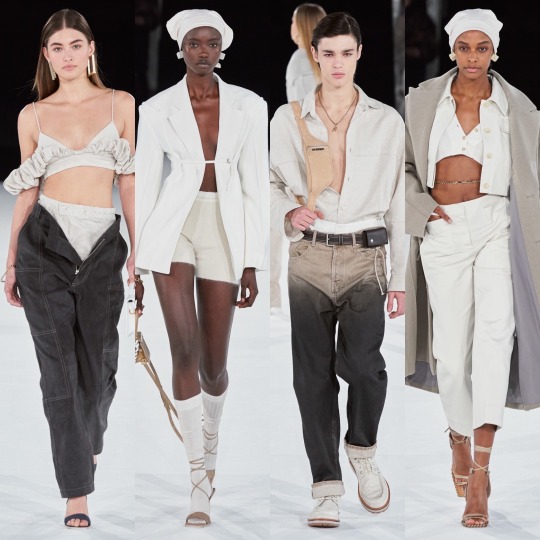

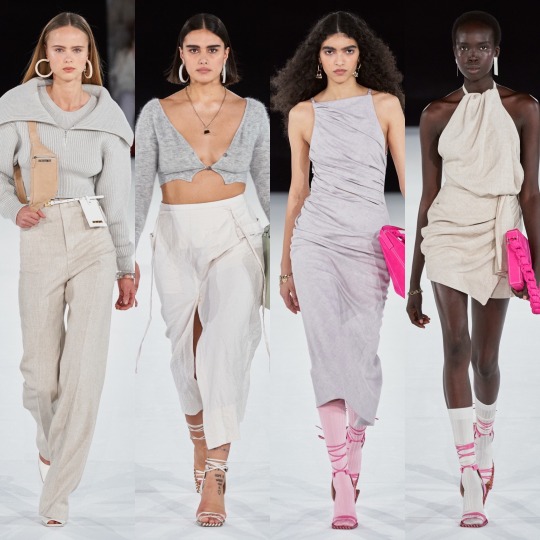

In a way, it kind of reminds me of Bottega Veneta’s last RTW show, in that, especially with the women’s outfits, we seem to be sticking with simple, fitted garments and chunky, more statement jewellery. I’ve got to say I like the styling here a lot more though, and in general I’m a fan of this collection. The collared tops with cut outs underneath blazers are cool and I can’t wait until it gets warm enough for me to not feel dumb wearing my headscarfs like this; there’s a LOT of summer outfit inspiration. It’s not a mind-blowing collection or anything but it is effortlessly sexy and that’s something I wish I could say about myself. Most of us can only hope to look half as good as these models do whilst making the effort but at least Jacquemus is aspirational, lol.
I also fucking adore this colour palette. I’m sick of neutrals literally just meaning brown and white; the navy, sand and muted khaki is a fresh edition to what is usually interpreted as the colours you’d seen worn by Disney’s Riverboat Cruise staff and only Disney’s Riverboat Cruise staff. And I mean, come on-what is more neutral than typical English school carpet blue.
Next for the whole reason I had to make this haute couture week review 2 separate posts: Jean Paul Gaultier’s final show.
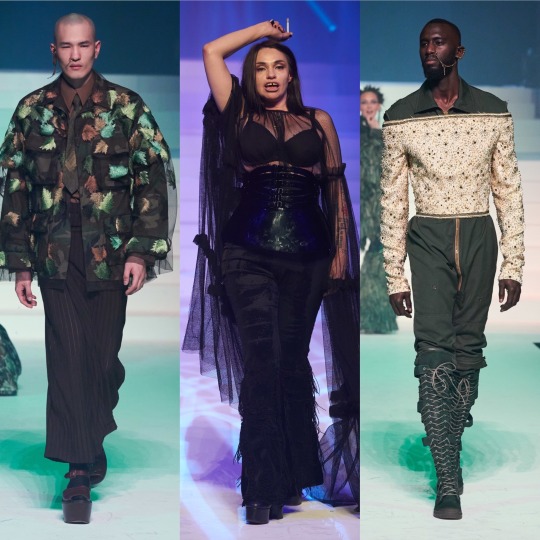



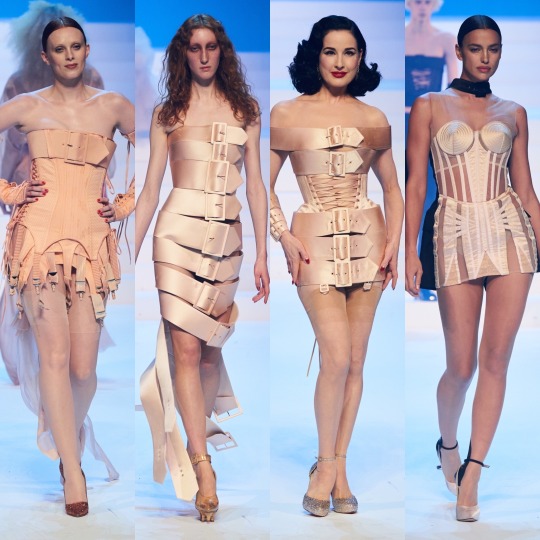

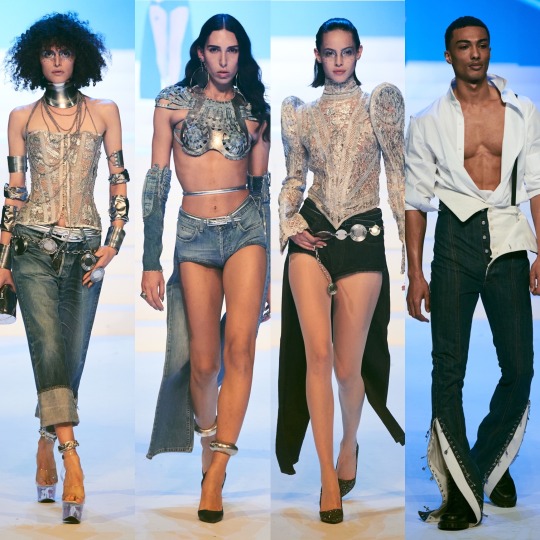

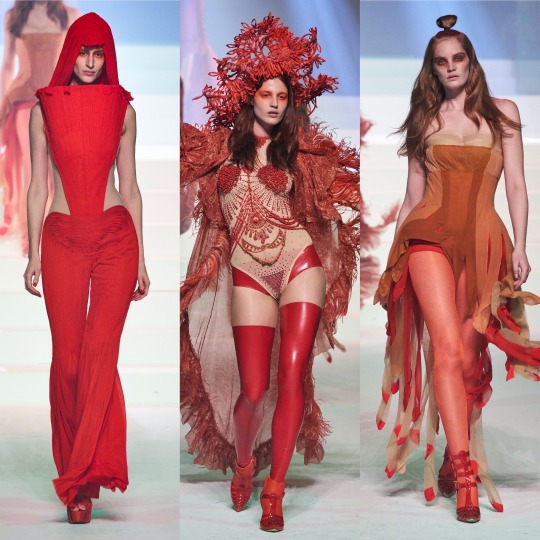

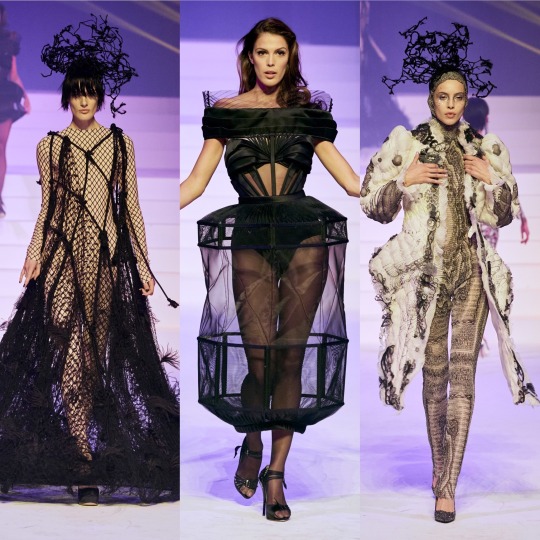
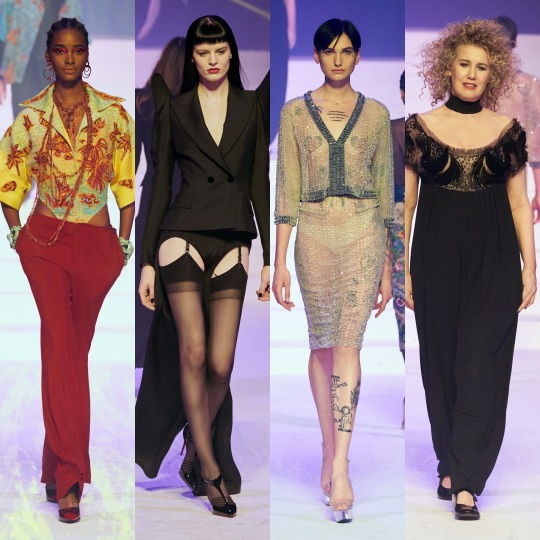


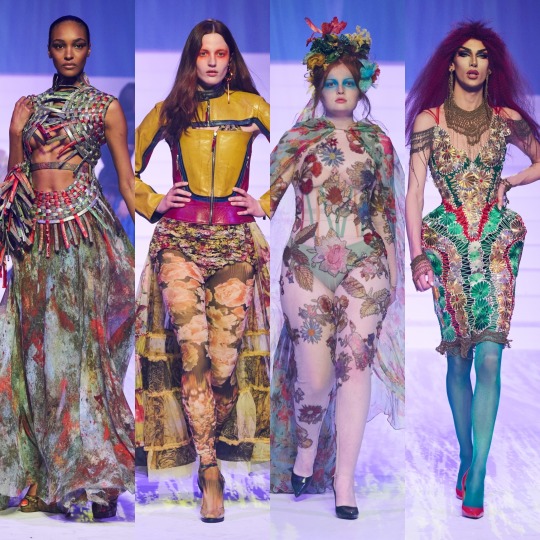

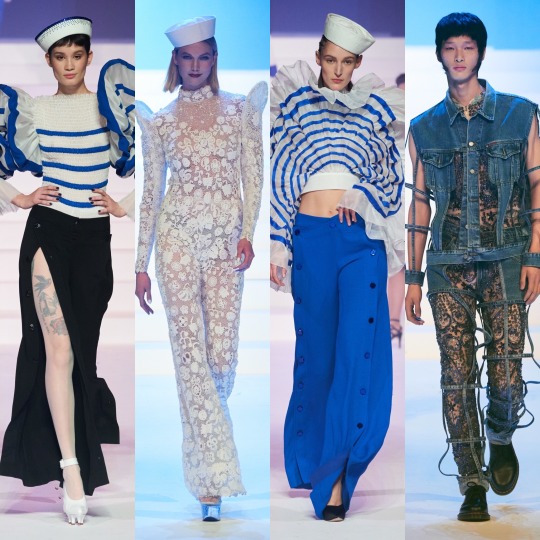
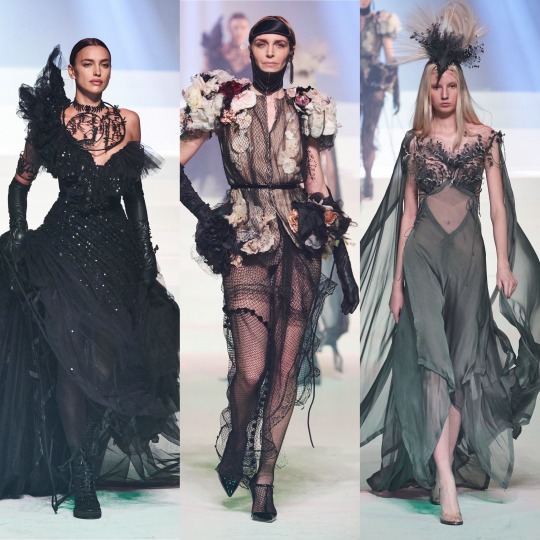





In the best way possible, it’s a lot. I don’t even really know where to start, except to say that I guess this is a fitting last show; a celebration of everything campy, messy, weird, performative, and punk is the perfect send off for a brand whose best known perfume of the last few years is called Scandal. More than anything, the final show represented the range of characters and cultures that have influenced JPG throughout his half-a-decade-long career, the lines that supposedly separate what is “masculine” and “feminine”, “old” and “young” and ultimately art and fashion blurred in the most exaggerated way possible. Sure, there are some looks which are individually a bit messy here but the way they were grouped into almost chapter-like segments meant that when you see them all together, they work. Nods to the patterns and structures that recurred from season to season were sprinkled throughout, from sailor stripes to corsets to the expected whirlwinds of colour. I’ll even allow the wellies in that one outfit; if I can get over bucket hats in Peter fucking Pilotto’s last RTW show, I can get over some questionable shoes here. Middle aged fishermen and boys who liked to pose with monster carp in their Tinder pictures as some weird display of masculinity everywhere rejoice.
Now onto a show that I personally found slightly disappointing: Margiela.

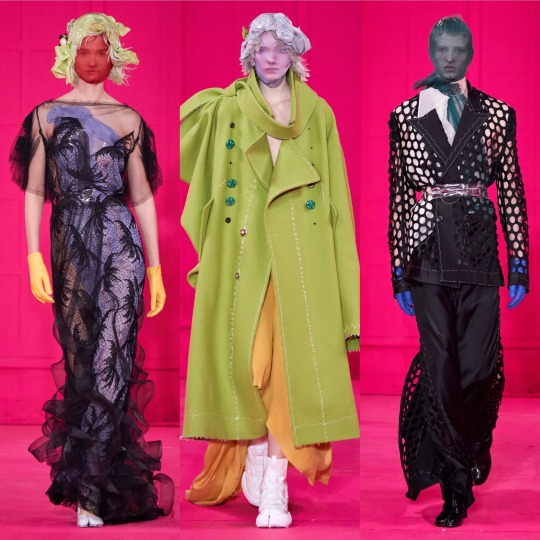
I think this one is a bit TOO weird for me. Like if you’re gonna go avant-garde, go all out. Chiffon gimp masks (I don’t know if that’s the intention here but that’s what I’m getting, sorry Maison) are something I’m not particularly fond of and I’ve never been a fan of the Tabi boots in the first place, let alone when they’ve seemingly been blown up to Michelin man style proportions. I didn’t find the show to be a total lost cause-I enjoyed the colour palette and I’ve always liked that contrast stitching detail, plus the bowler hats are interesting-but on the whole considering how much I liked the last RTW show, this is a bit of a let down.
The looks I included are salvageable but (I feel mean saying this) there were genuinely a lot of pieces that did just resemble bits of fabric draped over each over with no discernible rhyme or reason, so much so that they reminded me of some of the monstrosities I saw at a Drag Race pub quiz this one time where we had 5 mins to make some garms out of loo roll and then have a team member model them for points down a makeshift runway.
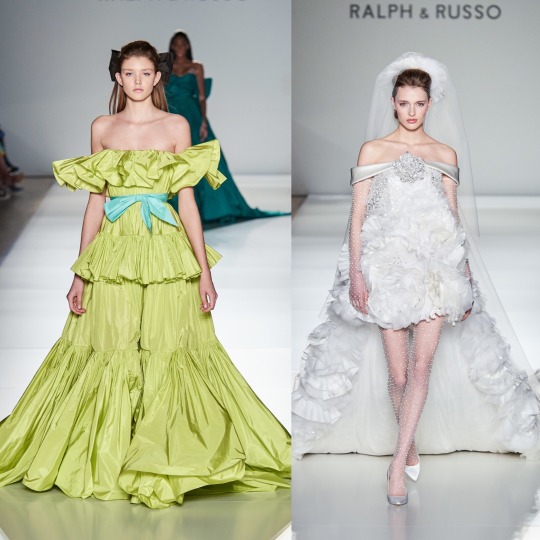
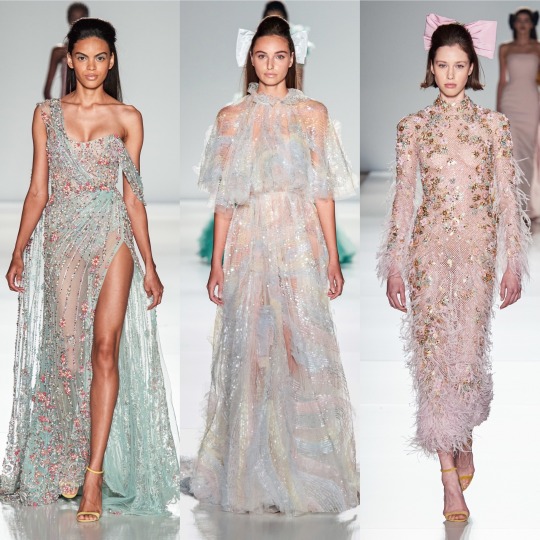
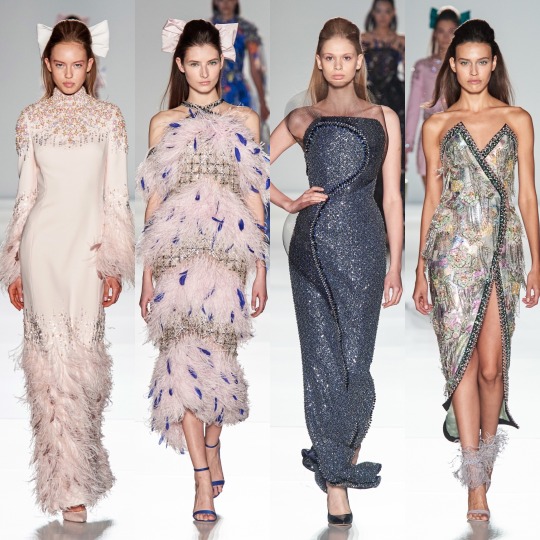
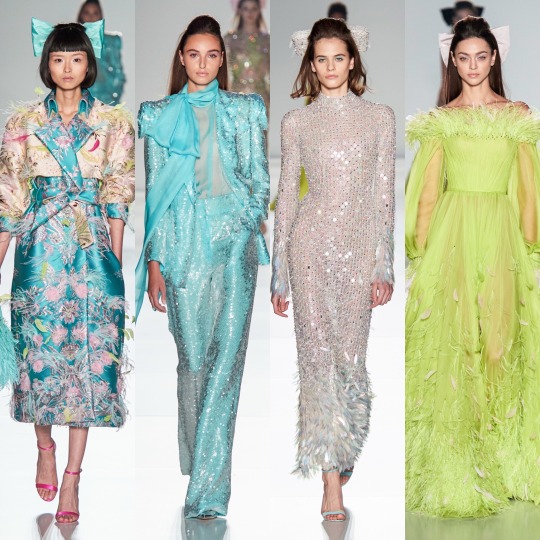
Ralph and Russo was alright. There were a few pieces that I really liked but again, I can’t help but compare this collection to the last, where it felt like the fussy details of bows and sequins and feathers and the Barbie Dreamhouse palette were utilised with a direction in mind. Here, I don’t get that. As ever, the gowns are gorgeous and I’d pay good money just to try one on for five minutes but as an overall collection I’d say there was a lack of higher vision, which is probably the snobbiest sentence I’ve ever written so forgive me.
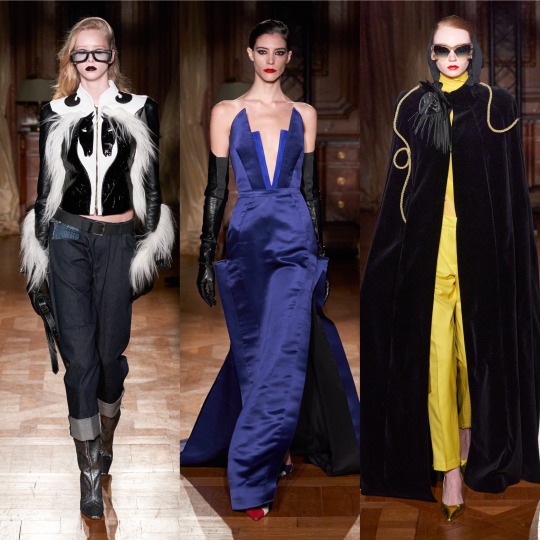
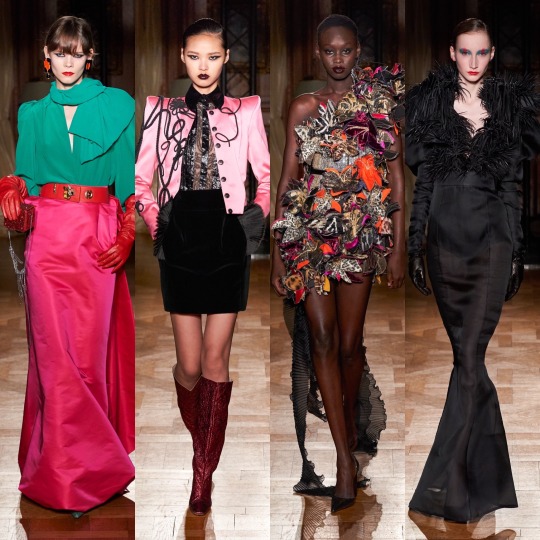
As for Ronald Van Der Kemp, I could’ve done without including it to be honest, if it weren’t for the few pieces I’m in love with: the velvet cape, fur trimmed jacket and blue satin dress are probably my favourite pieces here.
So onto a collection I liked a lot more: Schiaparelli.
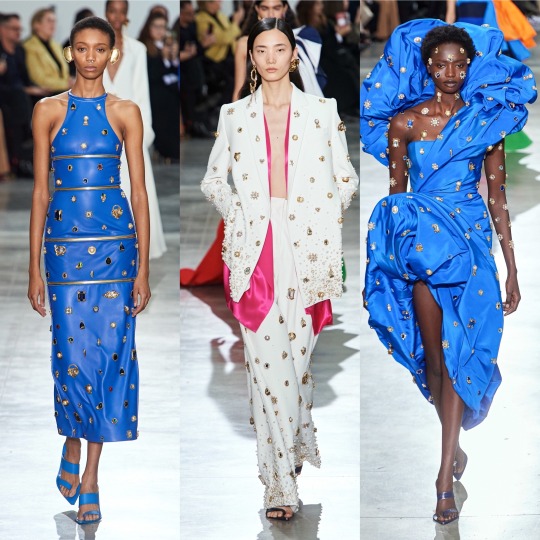
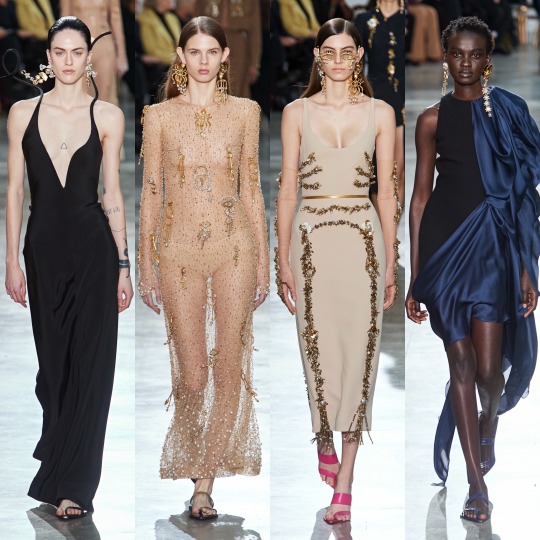



The influence of nature from flowers in bloom to insects to the organic structure of the human skeleton is as present as ever, though this collection includes a lot more delicate symbolism than usual. Honestly, the details make it for me; the brooches, earrings and facial jewellery are other-worldly touches to outfits that could otherwise be simple fashion magazine editor on-the-go. That’s not in itself a bad thing! The suits are gorgeous. I mean, I’m talking fashion editor in New York in a power suit yelling orders down the phone while she rushes along with a coffee. A Miranda Priestley in the making type woman. THAT’S a modern take on the divine feminine that Maria Grazia should’ve been going for; our goddesses aren’t women who sit around looking pretty (though that helps too) and place curses on mere mortals anymore, they’re women who get shit done.
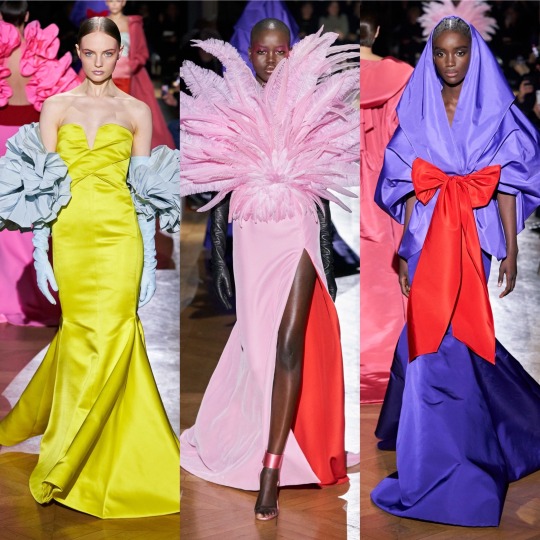





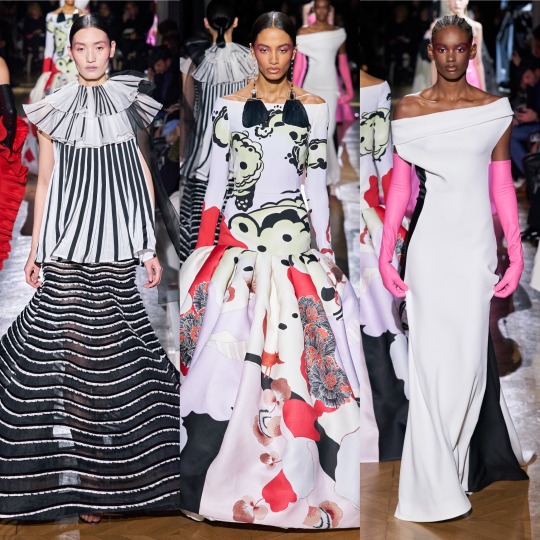
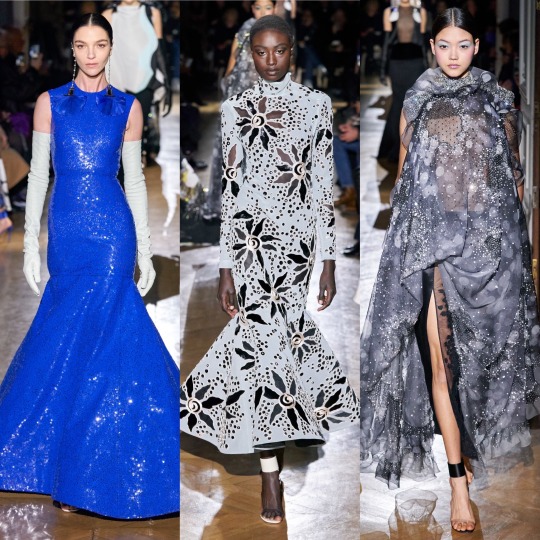
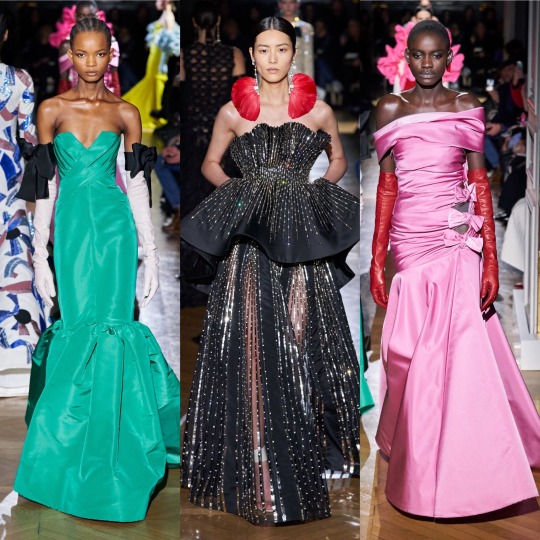

With regards to Valentino, which was also a delight, let me start by saying this colour palette is EVERYTHING. It’s ugly sisters in Cinderella fantastic, and we know those 2 were the real fashion icons really. Other than that, I adore the Old Hollywood silhouettes from the gloves to the Liz Taylor-in-Cleopatra-level-dramatic earrings. Everything is opulent and expensive-looking and pretty much what we’ve all come to expect from Valentino. A strong 8/10.


For me personally, Viktor and Rolf was a standout and one of my favourite collections of haute couture week. It’s not going to be everyone’s cup of tea and I know it’s at the complete opposite end of the spectrum to what was probably my other favourite collection, Elie Saab, but this is just my style down to a T, the perfect balance of grungy and cutesy that I want to achieve.
There’s probably going to be a lot of objections to the temporary face tattoos and I get that, but I think they’re fucking sick. I obviously wouldn’t get a permanent one lest my mother murder me in cold blood however if I did, you bet I would be pairing them with frilly-ass babydoll dresses that you could pick up in Camden Market like this.
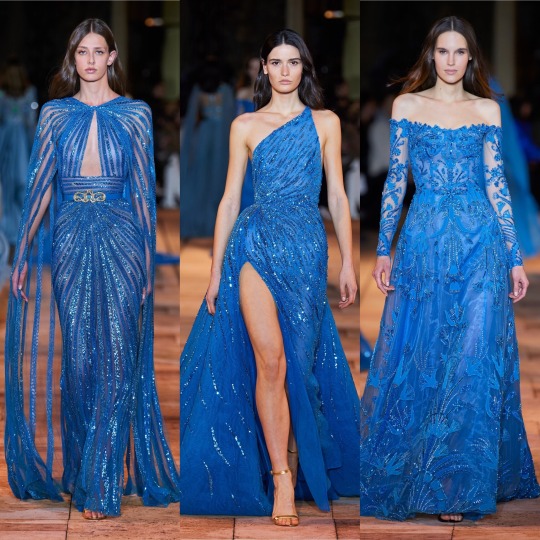
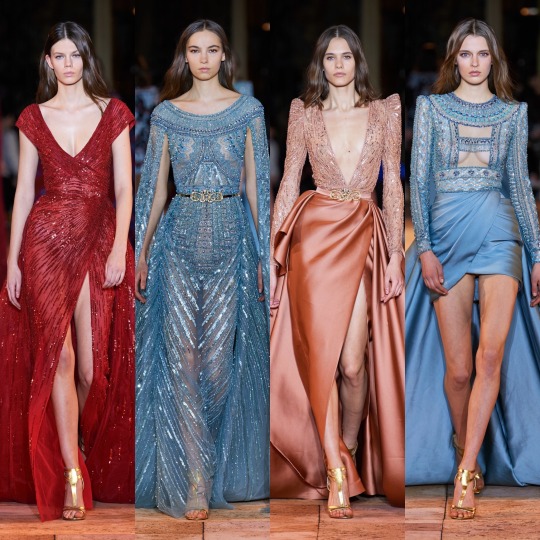


And last but not least (that would be Dior), there’s Zuhair Murad.
Sigh.
IDK, man. Seeing Zuhair Murad dresses on Tumblr and WeHeartIt (remember that site? It still exists!) as a 14 year old was one of the things that got me into fashion, so it sucks that almost every time a new collection comes around, I feel underwhelmed. Disappointingly, the brand hasn’t really progressed all that much since 2013. It goes without saying that the stoning and the embroidery and sequins are stunning and would make anyone feel like a princess but from a critical point of view, I’m just not seeing anything new here. Whereas I feel like Elie Saab, for example, reflected the growing fascination with East Asian fashion and recognition of the supremacy of the region’s street style in his haute couture last collection, Zuhair Murad seems to be stuck designing the same dresses he was 6 years ago.
To pick one example, the rounded stoned necklines are so outdated that they’ve been making their way onto department store prom dresses for years. I get that it’s supposed to be a reference to Ancient Egyptian style and I respect that, I was one of those 8 year old that was obsessed with mummies and the “Curse of Tutankhamun”, but couldn’t it be done in a more interesting way? It’s Maria Grazia’s spin on Ancient Greece all over again. Now I get how how the I imagine very niche subsection of people who are into fashion and Julius Caesar (okay, so I don’t even know if they still believed in mythology and all that malarky at that point in history but just roll with my comparison here) might’ve felt going through Vogue Runway. Anyway, I hate to end on a critical note and so be clear, these are still absolutely magnificent dresses. If we ignore those ugly round necklines, that is.
So that’s it for this post! If you read part 1 and 2, I hope you enjoyed it! As always, let me know your opinions and feel free to disagree. I’m literally just about to start trawling through all the A/W 2020 RTW collections though I imagine that’s gonna take me way longer to do than this, so I wouldn’t expect that for a month or two. In the meantime, I’m trying to fit shooting a Euphoria-inspired lookbook into my days off work which is looking atm like it’s going to be the end of March, so look out for that, and also a review of the red carpet fashion from this season’s award shows.
As ever, thank you so much for reading and again, thank you for the reception on part 1 if you were one of the people that read it. It makes staying up til 3am with the jitters seem worthwhile, lol!
Lauren x
#haute couture#haute couture week#pfw#pfw2020#paris#fashion#fashion week#designer#jacquemus#style#review#dior#sequins#pretty#aesthetic#zuhair murad#grunge#viktor and rolf#valentino#luxury#schiaparelli#georges hobeika#maison margiela#margiela tabi#jean paul gaultier#jpg#jpgaultier
136 notes
·
View notes
Text
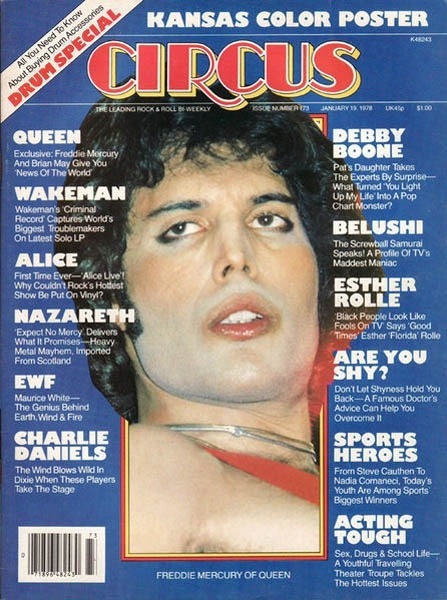
QUEEN DESERVES ROCK'S ROYAL CROWN?
by Rosy Horid
Circus Magazine 19 January 1978
Freddie Mercury and Brian May Hawk their ‘News Of The World’
Freddie Mercury is no longer the leader of Queen. Has he been fired, you ask, or is he off to pursue a solo career? No it’s simply, with the advent of News Of The World LP (Asylum) the personality of the music and of Brian May, drummer Roger Taylor and bassist John Deacon have come across more strongly than ever before.
Those who have seen them on the recent US tour notice more than ever before that they’re a group comprised of four separate identities, not just a lead singer and background band. Freddie Mercury is delighted to hear it.
‘I’ve never considered myself the leader anyway,’ says irrepressible Freddie. ‘The most important person, perhaps.’ And guitarist May agrees.
‘Our separate identities do come to the fore on this album, on which every cut is completely different from the one before it and there’s no concept at all. Apart from each having contributed two tracks to the album, Roger and John have been much more involved in the playing. Roger plays rhythm guitar on some of his cuts (‘Sheer Heart Attack’ and ‘Fight From The Inside’) which makes sense, because he had a better idea of how he wanted it to go. John plays acoustic guitar on one of his as well (‘Who Needs You’). I played maracas on it. While we may not do it that way on stage, in the studio that makes more sense.’
Brian also does a lot more singing of his own songs on News, but he’s content to let Freddie do the singing on stage.
‘He’s a natural performer,’ asserts Brian. ‘He acts on stage as if he was born doing it. That’s great for us. We wouldn’t want it any other way.’
As May and Mercury emphasize, it’s not just musically that shifts occur in the group.
‘John keeps a very close eye on our business affairs,’ says Freddie. ‘He knows everything that’s going on and shouldn’t be going on. If God forsakes us now the rest of the group won’t do anything unless John says it’s all right.
‘Roger is very important to us in a different way. He’s always been an out-and-out rock & roll fan with no time to stop and think about music and that’s very good for us. Instinct. He’s also the one who is most aware of facets in music, and that’s essential in the band. If you listen to ‘Sheer Heart Attack’ on the new album you’ll see what we mean. It sounds like a punk, or ‘new wave’ song, but it was written at the same time of the Sheer Heart Attack LP. He played it to us then but it wasn’t quite finished and he didn’t have time to complete it before we started recording. That was three years ago and now. . .almost all these records you hear are like that period.’ And Roger now? ‘He was into punk for a long time, but he’s tired of it.’ More about the album later.
But if you still don’t believe no crown of ladership rests on the mercurial head of Freddie, it’s worth repeating his comment about the composition of the group.
‘If anyone left Queen, anyone of the four, that would be the end of Queen. We are four equal, interwoven parts. And the others just couldn’t function the same without each quarter.’
Queen have just finished a special tour of the states. Not the longest they’ve ever undertaken, by any means, but special nevertheless.
‘It was the first tour we’ve ever done without the support band,’ Freddie explained. ‘There was so much going on on stage that I doubt there would have been room for another band anyway. We have so much material we want to play for people now that it would have been far too long a concert. It’s hard enough anyway to know what to leave out: we’d like to play all the new material, but there are some things we just would not dare leave out or I think the fans would lynch us.’
It was the sort of tour most rock bands dream of doing. Brian agrees: ‘We’ve managed to get some of the most sought after halls there are, even though the tour was short. Most of them are places we’ve played before. In some cities we had to settle for second, alternative choice auditoriums – the thing was set up so fast. It was also a very compressed tour – 35 dates in six weeks. We did very large halls because we wanted to do a fuller show and our rig was about twice as big as ever we used before.
‘It provided a complete stage environment, with an extension stage, three trailers and enormous lighting gimmick not just for New York and Los Angeles. That’s why we booked big halls, so that we could give everybody the complete show. We first used our crown centerpiece at London’s Earl’s Court concert over the Jubilee. At the time, we didn’t envisage being able to take the crown on tour with us, but we managed to have it demounted into a portable object. And so we had it for all the gigs. It made the most ambitious backdrop we’ve ever attempted, but it was worth it. The fans seemed to enjoy it and they are what matter.’
That last remark of Brian’s is typical of the group’s attitude towards their fans, for they have one of the closest rapports with the fans of any in the business. The same cannot be said for their relationship to the music press, however, especially in Britain. In fact, many people thought the chart-popping single ‘We Are The Champions,’ was Queen’s way of telling the press in no uncertain terms that they’ve made it without them. Others thought it an arrogant statement about their rock supremacy. But how do they feel? First Freddie, who wrote the song:
‘Certainly it’s a relationship that could be, but I was thinking about football when I wrote it. I wanted a participation song, something that the fans could latch on to. It was aimed at the masses; I thought we’d see how they took it. It worked a treat. When we performed it at a private concert in London, the fans actually broke into a football chant between numbers. Of course, I’ve given it more theatrical subtlety than an ordinary football chant. You know me.
‘I certainly wasn’t thinking about the press when I wrote it. I never think about the British music press these days. It was really meant to be offered the musicians the same as the fans.
‘I suppose it could also be construed as my version of ‘I Did It My Way.’ We have made it, and it certainly wasn’t easy. No bed of roses as the song says. And it’s still not easy.’
Brian concurs, ‘You know, songs aren’t always about what the words say. Messages in songs can appear different. I always see that as the difference between prose and poetry. Prose can mean exactly what it says, while poetry can mean the opposite. That goes for this song. Freddie’s stuff is often tongue-in-cheek anyway, as you know. This song is very theatrical. Freddie is very close to his art. You could say, he’s married to his music, whether it’s ‘I Did It My Way’ or his ‘There’s No Business Like Show Business.’ I must say, when he first played it for us in the studio we all fell on the floor with laughter. So many people in the press hate us because we’ve side-stepped them and got where we have without them.
‘But there’s no way the song says anything against our audiences. When the song says ‘we,’ it means ‘us and the fans.’ When we did that special concert, the fans were wonderful. They understood it so well. I know it sounds corny, but it brought tears to our eyes.’
Freddie and Brian are unanimous on that: the spontaneous responses to ‘We Are The Champions’ really move them. But that is the kind of general response News Of The World has received because, as Brian may says, ‘It’s a spontaneous album. I think we’ve managed to cut through to the spontaneity lacking in our other albums. I have no apologies to make for any of our previous albums. We’re proud of them and wouldn’t have let them out if we weren’t. But I now feel some may have been over-produced, so we wanted to go with a more spontaneous rock & roll based album. It was nice to do something that didn’t need such intensity. For example, with ‘Sleeping On The Sidewalk’ we did it in one take because it just seemed right the first time. We like to think of the album as a window on an unguarded moment, not a set piece. Each cut seems to do that, from the participation songs to Freddie’s mood pieces. Even his numbers on the album are different, from his heavy ‘Get Down, Make Love’ to ‘My Melancholy Blues,’ which is just what it says.’
Brian admits that his own material is different too. But he still tries to keep his private life separate and out of his songs as much as possible.
‘If you don’t keep something back, it can be very bad for you.’
But for the band both the album and the tour are in the past and they have to look at the future. They got back to England on Christmas Eve.
‘My mother would have killed me if I wasn’t home for Christmas. I haven’t missed one yet,’ says Freddie. And the others felt the same.
It’s time for some stock-taking. We’ve all become businessmen,’ admits Freddie, ‘even though it’s against our better judgment. It’s something that always happens if you get successful. Being a musician is not just cutting discs, unfortunately. I wish it was. We’ve all got companies now, some connected to music, others not. I’m producing Peter Straker, I have my car company. . . and lots of other fingers in other pies. We must take some time off to get things in perspective, or things will start to go wrong.
‘Then there’s been talk of doing a big world tour – Britain, South America, Japan, and of course the States as well as lots of other places. But that won’t be until later in the year.’
So, American fans will have a chance to see Queen in 1978.
‘You must tell them not to be too greedy, thought,’ warns Freddie. They’ve already seen more of us than any other country.’
And what about a message for the American fans, Freddie?
‘They know we love them. Apart from that, oh, say something outrageous for me.’*
72 notes
·
View notes
Text
Streetwear Has a Homophobia Problem
In September 2020, Highsnobiety renowned Tom of Finland, the late renowned artist understood for his masculinized homo-erotic art work. An excerpt of the interview and matching visuals from the artist’s structure were published on Instagram. Within 3 days of publishing, the channel saw a spike of 32,308 unfollowers. How attempt a design publication commemorate an artist who has had a large influence on style and culture at big? Many of the 3,500 remarks, unironically, concurred, and cluttered Highsnobiety’s post with freely homophobic declarations. “Officially unfollowing. Disgusted” stated one. “Nasty shit, time to unfollow,” stated another.
Not long prior to this, the Summer 2020 Supreme homage to ’80s period efficiency artist and night life icon Leigh Bowery was dealt with similar. “[James] Jebbia has a thing for weird AIDS infested artists,” commented one Hypebeast reader. After appearing in a Spitfire Wheels video, trans skater Cher Strauberry informed Thrasher Magazine in November 2020 that they got 40 death risks. A June 2021 post of Lil Yachty and Tyler, the Creator in blonde wigs on Complex’s Instagram account got a “Gay and gayer” remark.
The examples are merely the most recent in a multitude of frequently taking place events that show a growing belief amongst lots of streetwear afficionados that being gay, dressing gay, or associating yourself with anything LGBTQI+ is inappropriate in the scene. Any effort to challenge the streetwear culture visual or gender standards leads to a craze of aggressiveness. It’s difficult not to seem like streetwear is absolutely out of touch with popular culture, in spite of the 2 being better connected than ever. Why is the entire market in such contrast with traditional culture, especially the broader fashion business?
We’re calling it like it is: Streetwear has a homophobia issue.
The Trumpification of Streetwear
As Bobby Hundreds of LA-based brand name The Hundreds explains in his 2019 book This Is Not a T-Shirt, streetwear was when underground and powered by culture and neighborhood that was “down with the lifestyle,” and fans brought a sense of ownership over a brand name. It was when the bastion of counter culture fringe populations, consisting of early skaters, internet users, graffiti artists, punks, and hip-hop artists. Most individuals that used the item added to the scene, providing one genuine street cred that aligned you with a similar neighborhood. Seemingly, that state of mind belongs totally to a previous period.
“We often think of streetwear as some kind of small community, when really that hasn’t been the case for a very long time,” states Brendon Babenzien, who began his profession out at Supreme, established brand-new beloved on the block Noah, and just recently took the innovative reins at J.Crew. “Streetwear, as a term, used to describe a specific style, or in some cases, to define a certain culture. It’s no longer a small community of people with a shared ideology. It’s everyone, and unfortunately our culture is homophobic, often brazenly so.”


Now that streetwear as a subculture has actually ended up being the status quo, everybody and their mom is using hoodies. And while the marriage of these when diverse neighborhoods might appear forced or abrupt, there is one particular link that links a number of the fundamental subcultures.
“While each subculture has specific beliefs, norms, customs, traditions, and attributes, there are shared subcultural traits or common languages that includes hypermasculinity between them,” states cultural historian Elena Romero author of Free Stylin’: How Hip Hop Changed the Fashion Industry, and manager of the approaching exhibit “50 Years of Hip-Hop” at FIT in New York.
Here is where the huge dispute lies: many fringe subcultures connected by a main identity of aggressive masculinity have actually come head-to-head with a more comprehensive culture avoiding this really particular as no longer perfect. The cis white male supremacy of streetwear has actually never ever been as interrupted as it has actually been over the previous years when it got in the haute couture market and, with it, its myriad of LGBTQI+ designers. Riccardo Tisci’s Rottweiler Tee Shirts for Givenchy Fall/Winter 2011, followed by his very first restricted edition Nike AF1 collab in 2013, altered the streetwear market. So did Kim Jones, who was among the earliest leaders of combining street and high-end when he was Creative Director for Umbro back in the early 2000s through to his Stüssy cooperation at Dior Homme. Shayne Oliver’s greatly queer-influenced brand name symbolized a brand-new period for streetwear from the underground. Not to discuss the transformative flirts with fluidity by the hip-hop celeb cognoscenti that turned streetwear on its head. Think Frank Ocean’s coming out letter on his tumblr in 2014, or Pharell and Kanye’s pink stage, followed by Yeezy using a Givenchy by Riccardo Tisci kilt in 2013, all signifiers of “non-traditional masculinity.”
Streetwear, as a term, utilized to explain a particular design, or sometimes, to specify a particular culture. It’s no longer a little neighborhood of individuals with a shared ideology. It’s everybody, and regrettably our culture is homophobic, frequently brazenly so.
Brendan Babenzian
What the majority of the cynics don’t realize is that streetwear has been in ltr with sexual fluidity for some time now. Some of the most sought-after products are directly linked to alternative voices and cultures. The reality is that streetwear culture has become fully pansexual.
Yet homophobia in the streetwear community is so blatantly expressed because homophobic beliefs are not hidden in the cultures that have inspired them. “With hyper-masculinity comes a bravado of boasting that speaks to individuals’ great pride and ego,” Romero continues. “This covers everything from physicality, fighting ability, financial riches, sexual prowess, coolness, and skill sets, to the ability to get the hottest chick or ride in the game. Heteronormativity has been the lens on which youth culture and fashion has seen itself and marketed to.”


Most of all, there is a segment of streetwear fans that strongly want streetwear to return to a closed community, to keep it sacred, special, and most of all, theirs. It’s the Trumpification of streetwear: “Let them have the high fashion, this is ours,” they seem to be screaming.
The luxury industry, traditionally driven by queer creatives, tends to be more open-minded when it comes to change; more trendy. So when luxury, streetwear and hip-hop started to merge in a bigger way over the past decade, we expected there would also be this seamless exchange of values. The exchange, however, never happened. Why?
“It can be argued that gay culture has been central to the creation of modern fashion. The gay level of fashion contributions in streetwear is nowhere near as significant. The fashion is reflective of the culture. I wouldn’t say it has been intentional, but early fashion designers have been predominately heterosexual males. This will evolve, but I don’t see a dramatic shift [happening] anytime soon,” says Romero.
There’s also the issue, which no one talks about, of young men feeling slightly alienated by what is going on. Of not being able to find that identity, or maybe channeling [it] into an unhealthy identity because they can’t really find a way to communicate.
Sofia Prantera
“There’s also the issue, which no one talks about, of young men feeling slightly alienated by what is going on. Of not being able to find that identity, or maybe channeling [it] into an unhealthy identity because they can’t really find a way to communicate,” says Sofia Prantera, who started out at London’s Slam City Skates, Europe’s first skate store, in the ’90s before founding streetwear brand Silas and currently heading up Aries. “They feel that they don’t have their own label. That’s the danger; bringing up young men who are attracted by bigotry as a way to identify with their own group.”
These angry voices can’t only be OGs wanting to go “back in the day,” so who are these toxic forces, and what do they know about the true values and soul of streetwear? What should a culture who once cradled a community of outsiders seeking to belong do to curb this wave of hate?
The Role of Brands
Elissa Steamer heads up surf and skate brand Gnarhunters. In the late ’90s, she became one of the the first pro female skaters (later immortalized in Tony Hawk’s Pro Skater). As a queer woman who entered the overwhelmingly straight male industry, she has seen just how much has changed from when she first began skating. “People would drive by and say derogatory comments out the windows of their cars, or pull up and try to start fights. Just for riding a skateboard,” she tells me about the beginning of her career in Florida.
Now, while not perfect, skating has become considerably more inclusive, though you’d be fooled for thinking that from a casual social media scroll. In Steamer’s experience, it’s not the true skate community that is raging verbal war on the LGBTQ+ community. “If you’re skateboarding, anything that’s hateful and exclusionary ain’t gonna fly, you know what I mean? So the people disparaging us have to be on the sidelines, on the fringes. Because nowadays, if you make a sideways comment, you’re going to get called out for it.”


Iconic creative director Paul Mittleman of the original Stüssy tribe, adidas, and Converse tells me how growing up in a 1980s-era New York plastered with ACT UP against AIDS posters left its mark: “One of the first Stüssy accounts was at Patricia Field, the place that attracted everyone who had no home.” Queer, club, graffiti, and street cultures rubbed shoulders, in a true New York come-as-you-are freak cocktail.
This initial activism, however, is a blip in a long-gone era that is lacking that kind of ally-ship today. With more sets of eyes on streetwear, it has become clear how much is actually broken. Streetwear was built on community: from us, for us. And though it was formulated as a communal safe space for outsiders of all stripes, an exclusionary stripe has always persisted in skewing towards cis white straight men.
“[Homophobia] has always been there,” Babenzien confirms of this streak. “I’d say the [cultural] events leading up to these questions really just gave people an opportunity to express their views, so it may feel like a new thing. But it’s not new.”
They feel that they do not have their own label. That’s the danger; bringing up young men who are attracted by bigotry as a way to identify with their own group.
“If you’re asking if fashion brands and artists have a role to play in sending messages of equality, then yes,” he continues. “But I think it’s bigger than just brands that think of themselves as streetwear. Homophobic behavior exists deep in the core of our entire system; in all industries and every corner of our communities. We need to see people different from us as still equal to us. That is a massive behavior shift that will take time.”
Sofia Prantera argues that streetwear brands certainly have a role to play in addressing the issues that are plaguing the scene: “As a brand, you really have to be true to yourself. Otherwise you’re just embracing everything and becoming no one’s, becoming nothing. It’s really hard to make a difference to a lot of people, but it’s very easy to make a difference to a few people. It’s super important as a brand because you can really make [that] difference.”
What Does Doing Good Even Look Like?
Perhaps a more effective vehicle of change, in a quiet way, may be by demonstrating by example.
Take Virgil Abloh, whose casting of integral queer personalities into the mix goes a long way for his audience. GHE20G0TH1K-veteran Ian Isiah sang along with Dev Hynes at his second Louis Vuitton show, and his last Louis Vuitton presentation was the epic video directed by trans director/artist Wu Tsang, collaborator of Hood by Air alum Tosh Basc (formerly Boychild) and trans model and poet Kai Isaiah Jamal (who pointedly told Highsnobiety that representation needs to be more holistic: “what we visibly put out to the world is slowly progressing, but behind it, I need to see myself reflected”) . That has actually a lot more impact than throwing a rainbow on a sneaker. Or look no further than this month’s Balenciaga show, where one of today’s premier hype boy brands closed a runway presentation with an homage to a queer cult classic and one of the the most iconic drag queen of all time.


If you continue to look in other areas of the community, change is happening there, too, slowly. There Skateboards is possibly the first entirely queer skateboard team and company, while the trans-led skate brand GLUE counts among their ranks Cheryl Strawberry, who was featured in Gucci Fest and works at Supreme, while the brand’s Leo Baker appeared in Nike’s all-female skate video GIZMO with Elissa Streamer, who sums up the new attitude. And it’s worth commending Supreme’s consistent showcase — whether it sells out or not — of LGBTQI+ culture and artists like Andreas Serrano, Leigh Bowery, and Nan Goldin.
Of course, more needs to be done. Doing good doesn’t just look like LGBTQI+ models and in-house designers, but hiring people from the culture and community who can lend authenticity and lived experience, not just tokenism. Brand ambassadors by brands that are more affordable/accessible for young people is also essential. So is media support: not just Highsnobiety, but Thrasher Magazine, Hypebeast, Complex, and more profiling queer artists, community leaders, and industry shakers with the same respect and diligence as their straight counterparts.
More than any of these other changes, what needs to happen (and what all of us are perfectly capable of ensuring takes place) is that homophobia in streetwear needs to be tackled with the same ardor as anti-racism or anti-misogyny in the culture. Everyone in this community is united by their love of the culture, and everyone in it deserves to be treated with the basic human dignity they deserve. If streetwear fans don’t adapt to this mindset, it will very soon ended up being a problem for them, too. They will be a polarized minority that is hijacking streetwear to project an identity that is out of touch with society. From brands to fans to publishers like this one, we all have actually a big part to play in re-indoctrinating the core notion that streetwear is for everybody. From every color of the rainbow. Bruh.
Source link
from Skate World. Skateboard News, skateboard shop https://ift.tt/3A6rKcp
0 notes
Link
RICHARD SPENCER ISN’T having fun anymore. In a lengthy YouTube video posted on Sunday, the white nationalist announced that he would be suspending upcoming public speaking engagements and halting his controversial “college tour.” He said of his rallies, “When they become violent clashes and pitched battles, they aren’t fun.”
“I really hate to say this, and I definitely hesitate to say this,” said the poster boy of the so-called alt-right. “Antifa is winning to the extent that they’re willing to go further than anyone else, in the sense that they will do things in terms of just violence, intimidating, and general nastiness.” He stated that the willingness of far-left activists to use any means necessary in attempts to shut down his speeches has left the far right “up the creek without a paddle.”
...
A cottage industry of panicked media commentary has dedicated itself to decrying the threats antifa and its “no-platforming” stance pose to free speech. Suffice it to say this all-too-prevalent media position is deeply flawed. The aspect of those criticisms that is relevant for our purposes here is the claim that antifa action is not effective. Critics even claim antifa’s approach is counterproductive, giving oxygen to the attention-grabbing white supremacist fire it would extinguish.
...
Spencer’s latest message suggests the very opposite. “The idea of a college tour was going into the belly of the beast — going into academic, Marxist-controlled territory — and giving a speech that introduces that basic ideas of identitarianism and the ‘alt-right,’” he said in his video, emphasizing the use of “public-facing” events to spread and normalize the “alt-right” message. Anyone who has watched Spencer and his ilk in public debates with liberals on the question of race should see how the belief that his violent white supremacy can be reasoned away is flawed. He sticks to his guns about the necessity of a white “ethno-state,” and his liberal interlocutor calls him a monstrous racist. The result is that anti-racists agree with the liberals and racists agree with Spencer. The effect, as both sides hold to their arguments, is mere entrenchment of an intolerable status quo — or, worse yet, closet racists decide Spencer’s arguments license them to come out publicly, too.
INSTEAD OF THIS deteriorating stalemate, the antifa strategy aims to create material, felt consequences for neo-Nazi, white supremacist groups, and those who would organize with them. The approach takes seriously that young, white, often alienated men see promise, belonging, and elevation in these organizations. They don’t join groups like Identity Evropa, an American white supremacist group which has focused heavily on campus propaganda, because of the strength of their arguments — and they won’t leave such communities because of the flawed logic of their ideology, either.
To make the consequences of joining the white nationalist movement appear less appealing — to take the “fun” out of fascism — is precisely the antifa strategy to stymie the movement’s spread. Spencer stating that his rallies are no longer “fun” is music to antifa ears.
It is no accident that antifa tactics beat back the rise of neo-Nazism in the 1970s and 1980s punk scene, or that fighting squads of Jewish ex-service members halted the upsurge of Oswald Mosley’s anti-Semitic, fascist organizing in Britain after World War II. And it’s no surprise that the so-called alt-right has been forced to reconsider its tactics today. While writers for the New York Times opinion section may seek to paint the antifa position as little more than punch-seeking thuggery, the strategy of creating serious consequences for white nationalists who would organize is based on a well-grounded understanding of the desire for fascism and how it spreads.
7 notes
·
View notes
Text
Black Entertainment and White Consumption: Past Vs. Present
For centuries now, Black people have been seen as a source of entertainment for white people but are still silenced to this day if they speak out against the way they're treated. Since the very day Africans were stolen from their countries and forced to work for Europeans, they've also been forced to entertain the entire time—whether through music, sports, fighting, or any other creative outlet through which they shine.
The entire global music industry (as well as our entire sports industry) as we know it has been built on the backs of black Americans. It is perplexing, infuriatingly so, that in our current times, black Americans are being shunned, ridiculed, and scolded for speaking up about the way they've been used and abused since they were trafficked here. Beyonce, Kendrick Lamar, Sam Cooke, and every other black artist that has spoken out against racism in America deserves to be heard and understood.
Black Entertainment in the Past
During slavery, enslaved Africans found many ways to fill what little free time they were afforded. Typically, these ways included singing, dancing, drinking, wrestling, etc. (Lussana, 2010). In some areas and on some plantations, the slave owners would join them, as told by Henry Bibb, a former slave. They would laugh and drink together, play music, and engage in fights. The slave owners watched the men fight each other and gambled on who would win (Bibb, 1849). This may seem like a more positive aspect of slave life, but in fact, it is quite sad that slave owners were able to see slaves as people enough to drink and party with them, but not enough that they deserved freedom. The point is reiterated; Black people are only as valuable to white people as what they can do for them.
This mentality continued well past slavery and was seen quite often in the emerging music industry. For example, Jazz music was made popular by Black artists, but was soon overtaken by white artists and white run record companies. It was monopolized by whites, and Black artists were shut out. As stated by Lynne Seago, “Racism in Chicago during the 1920s changed jazz from a potent and distinctly N***o [outdated term for African Americans] style of music to a diluted by-product of mainstream popular culture.” She goes on to explain that, in typical fashion, Jazz music started as something seen by the white community as “immoral” and referred to it as “whorehouse music” until it became popular among white artists. Only then did they decide that it was an artform, and only then was it considered acceptable music. Seago goes on to say, “While black musicians were stuck playing for a limited, African-American audience, white jazz was becoming increasingly popular across the nation, to the point where there was even a ‘widespread denial in America of the black man's role in the creation and development of [jazz]).’” This is something that continues to happen today. Black culture is continuously robbed and then denied of what it has created once white people pick it up and bring it to the mainstream.
Going over the history of music and its evolution, a common theme is that the Black artist community created a new subgenre of the music they used to make as a way of reclaiming that music for themselves. A few examples of this would be the creation of Soul music as a way to reclaim RnB, Funk as a way to reclaim Rock and Roll, and Hardbop as a way to reclaim Jazz.
Hardbop is a genre similar to Bebop which was another subgenre that’s purpose was to reclaim Jazz. The difference between them, as explained by Walk That Bass (a popular Jazz piano instructor), is that Bebop was a more artistic, abstract form of music with more difficult melodies and faster tempos. It wasn’t made for dancing, and that’s where Hardbop came in. Hardbop had simpler melodies and a more bluesy vibe.
Jack Trudell explains that Hardbop was created as a resistance to segregation, Jim Crow laws, and as a reaction to the popularization of “cool Jazz”. The response to this movement by Jazz critics was harsh and tells an age-old tale of white people feeling attacked and offended that Black people dare speak up about the harsh realities of their existence. A notable white Jazz critic (it can be argued that no white person with views that deny the Black influence on and creation of Jazz music should even be considered a Jazz critic, but I digress) by the name of Martin Williams wrote in his essay titled “The Funky-Hard Bop Regression” wrote, “The gradual dominance of the Eastern and then national scene in jazz by the so-called "hard bop" and "funky" school has shocked many commentators and listeners. The movement has been called regressive, self-conscious, monotonous, and even contrived.” This mentality shared by white listeners and artists dates back to the moment that they brought enslaved Africans to America, and it persists to this day—"Black people are meant to provide us with services and nothing more. Anything more than that is hostile, regressive, and made-up.”
Black Entertainment in the Present
As we fast forward to the 1980s and present day, we still see the same patterns of Black suffering and White fragility. Hip hop was created as a resistance movement against police brutality and white supremacy in the urban setting. It was an exclusively Black (and some would argue Latino) movement, and it was demonized by white people until it became popular in the 80s. Rap/Hip hop were seen as violent and misogynistic, and the Black adolescents and artists that engaged with it were often victims of severe institutionalized racism. As explained by Rachel Sullivan, they were given less opportunities to record under contract, and even less opportunities to go on concert tours because the insurance companies would not insure their concerts due to the belief that the artists and fans were violent.
This mentality would be cemented even more by the white politicians of the time publicly shaming and demonizing Black artists. For example, then Vice President Dan Quayle went after Tupac Shakur (and did not bother to pronounce his name correctly) for “promoting violence”, while the President George H.W. Bush went after Ice-T for his song “Cop Killer”. The irony of these statements was that 1) neither of these politicians had listened to the albums in question, and 2) Ice T’s song was a collaboration with a punk group named Body Count.
But, as we have always seen, once Rap and Hip hop became popular, it was taken over by white audiences. White youths outside of inner cities began to pick it up as fans; however, the rap that discussed racism and the struggle of being Black in America was not popular among these white fans. This marks the start of the decline in popularity for political Rap and Hip hop.
Skip forward to present day, and political Rap and Hip hop have made significant comebacks because of the severe civil unrest we are facing due to the unlawful and unjust deaths of Trayvon Martin, Michael Brown, Philando Castile, Sandra Bland, Tamir Rice, George Floyd, Eric Garner, and too many others. The civil rights movement we are experiencing currently is the largest in the history of the U.S., and still, there are white critics who continue to demonize Black artists who speak out against white supremacy and police brutality, while simultaneously enjoying the fruits of the artists’ labor.
One of the most startling examples of this is white people’s love-hate relationship with Beyoncé and her husband, Jay-Z. They have been outspoken since the shooting of Trayvon Martin, which was the start of our current civil unrest. Trayvon’s death made national news because of the obvious racial motivation behind it. He was shot while walking home from the convenience store by a more affluent Latino man who claimed that Trayvon was acting suspiciously and may have had a weapon. In reality, Trayvon had nothing more than a hoodie, a packet of Skittles, an Arizona tea, and black skin. This shooting brought the conversation of anti-black racism back into the mainstream, and Michael Brown’s unlawful shooting incited riots over police brutality. Beyoncé and Jay-Z immediately spoke out against these incidents and condemned police brutality and racism. Jay-Z also produced a docuseries on the shooting of Trayvon, and Beyoncé’s 2013 Superbowl performance was a celebration of Black culture and heritage.
Said performance was met with intense backlash from conservatives, namely white conservatives. Rudy Giuliani, the former mayor of New York City, called the performance “outrageous”, and “an attack” on police. This sentiment was held by many white Americans, with many threatening to boycott Beyoncé, if she did not “tone down” her public politics. Of course, this only spurred her on to make more music that empowered the Black community, namely Black women.
Historically, white people have always loved to watch Black artists perform and be excellent in their field while silencing them when they spoke on more serious topics. What’s even more upsetting is the simple fact that white people today say the same things and share the same mentality that slave owners in the 1800s did. "Shut up and perform, I'll treat you however which way I want, and you just have to take it.” What’s interesting is that they cannot see how deeply racist such a sentiment is. Interesting also that they will take a businessman's word as gospel when it comes to politics but won't take a black artist’s word when they discuss the racism they still face in their field and in the world.
White people must understand that they do not get to partake in Black culture, do not get to enjoy their craft, if they do not support the Black community as people. Music is largely black-influenced and black-supported, and people do not get to enjoy it if they do not support the people who make it possible.
References
“From Potent to Popular: The Effects of Racism on Chicago Jazz 1920-1930” by Lynne Seago
“Hard Bop (& Soul Jazz) Explained” by Walk That Bass http://www.thejazzpianosite.com/jazz-piano-lessons/jazz-genres/hard-bop-soul-jazz-explained/
“A Jazz Revolutionary” by Jack Trudell http://socialistworker.org/2006-2/603/603_13_Coltrane.php
“Hard Bop and Its Critics” by David H. Rosenthal
“Protesting Police Violence, a Playlist” by Juan Siliezar https://news.harvard.edu/gazette/story/2020/07/hiphops-long-history-of-exposing-police-brutality/
“Slouching Toward Bork: The Culture Wars and Self-Criticism in Hip-Hop Music” by Jeffery O.G. Ogbar
“Rap and Race: It's Got a Nice Beat, but What about the Message?” by Rachel E. Sullivan
“Trayvon Martin: 5 ways Beyoncé, Jay-Z have kept the conversation going” by Todd Stewart https://www.orlandosentinel.com/entertainment/os-et-trayvon-martin-beyonce-jay-z-20180620-story.html
“Beyoncé’s Super Bowl Halftime Show Criticized by Rudy Giuliani as ‘Attack’ on Police” by Ryan Parker https://www.hollywoodreporter.com/news/beyonces-super-bowl-halftime-show-862947
0 notes
Text
BLM x EDM: A Moment to Appreciate Black Artists in Electronic Music
By Diana Lustig and Isiah Kurz, Kusheen Magazine
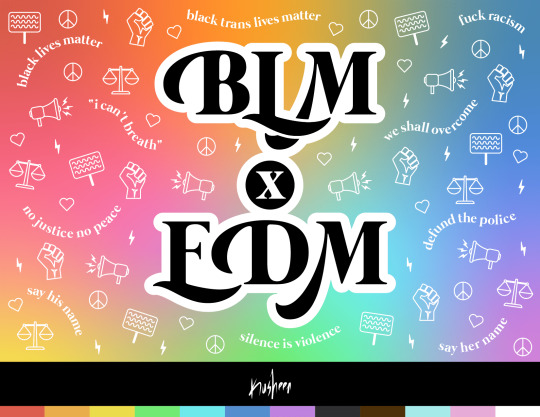
Only half-way in and 2020 is already turning out to be a mindfuck of a year. COVID-19 all but eliminated live music. The economy tanked all but a few essential industries. And systemic racism came to a head with the deaths of George Floyd, Breonna Taylor, Ahmaud Arbery and so many others. Yeah, 2020 has been a shit year by all counts.
But despite all of this, I am working hard — desperately hard — to find some hope. Even with the coronavirus shuttering venues and festivals, thousands of incredible artists provide livestreams to keep our spirits up. Even though the economy took a nosedive, it was funny to note that booze and cannabis are deemed “essential.” And even in the face of tyranny and police brutality, we have seen an entire globe rise up in stern rebuke calling for justice and equality.
Yes, 2020 is a hellstorm. But as they say: the mind is its own place, and in itself can make a hell of heaven.
In that same spirit, Kusheen wants to take a moment to appreciate and celebrate a few of the black artists that have contributed to EDM culture, while acknowledging the rich history of gay and black culture that has brought the electronic music scene to where it is today.
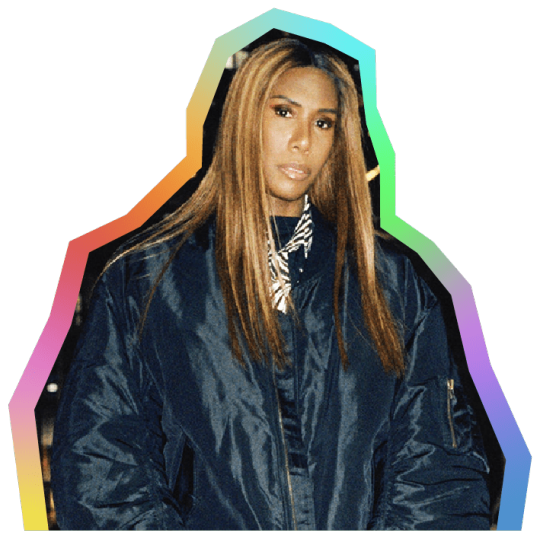
Honey Dijon
Honey Dijon is a mixologist extraordinaire—and I’m not talking about cocktails. It takes an adept DJ to blend Detroit house, Chicago jack and Euro electro into something as sweet and savor as a Honey Dijon mix.
Born Honey Redmond, Honey Dijon grew up in the south side of Chicago where she was mentored by such influential names as Derrick Carter, Mark Farina and Greenskeepers. Honey Dijon has since moved out of Chicago to split her time between New York and Berlin, Germany — sharing the best beats across the Atlantic and back.
“For me, house music has never just been about DJing and fashion has never been about clothing,” she says. “It’s always been about the possibility of a more beautiful life.”
Beyond her career as a DJ/Producer and fashion icon, Honey Dijon is also an activist advocate for trans rights and awareness, speaking from her own experience as a black trans woman in the dance music scene.
“The DJ world is still a boy’s club in a lot of ways,” Honey Dijon told the New York Times in 2013. “I’ve always wanted my talent to speak for itself. I didn’t want ‘black’ or ‘trans’ or any of it to speak for me. Now I am beginning to realize the importance of it because there is really hardly any visibility for black trans women.”
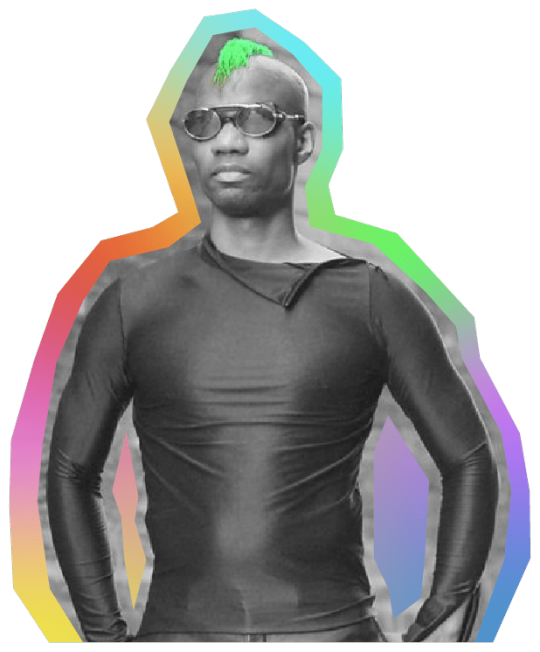
Green Velvet
Curtis Jones has gone by many names over the years: Cajmere, Geo Vogt, Half Pint, Curan Stone, Gino Vittori — and of course, Green Velvet.
Green Velvet is one of my favorite go-to artists. His sound is perfect for a house party with friends, sweating at the gym or driving too fast. He’s also an electro heavyweight who has put his time into the scene.
Way back when, Jones left a master’s degree in chemical engineering to focus entirely on a career in music. And while I’m not sure about his chemical engineering, I do know he has a talent for engineering music with a unique sound; from the punk-inspired track “Whatever” to the jocular song “Flash,” Green Velvet is always pushing creative tunes with creative lyrics.
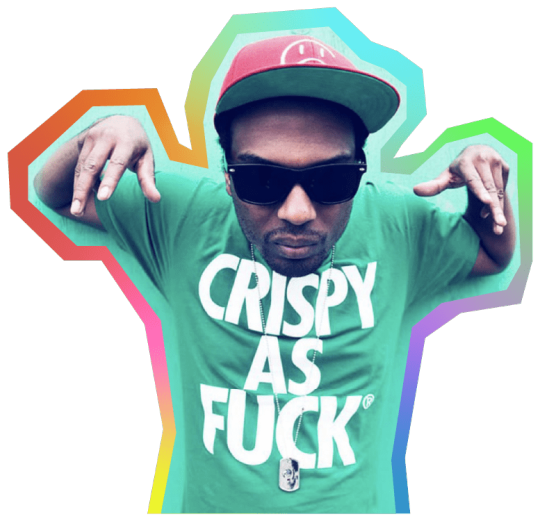
12th Planet
Straight out of Los Angeles, John Christopher Dadzie (aka 12th Planet and Infiltrata) is an American dubstep producer who has collaborated with some of the biggest names in EDM, including Skream, Russo, Kill the Noise, Diplo, Datsik, Doctor P, and Skrillex. 12th Planet is so influential that some music critics credit him as one of the first ambassadors of dubstep in the United States. Rolling Stone even named him the “Los Angeles dubstep god.” And that he is. Thriving in the underground scene of Los Angeles where he, along with his label SMOG Records, have brought the British dubstep movement stateside.
If you’ve been to a big ticket festival like Coachella, Lollapalooza, EDC, Hard or Ultra, you’ve almost certainly seen him on the lineup — if not at one of his sets.
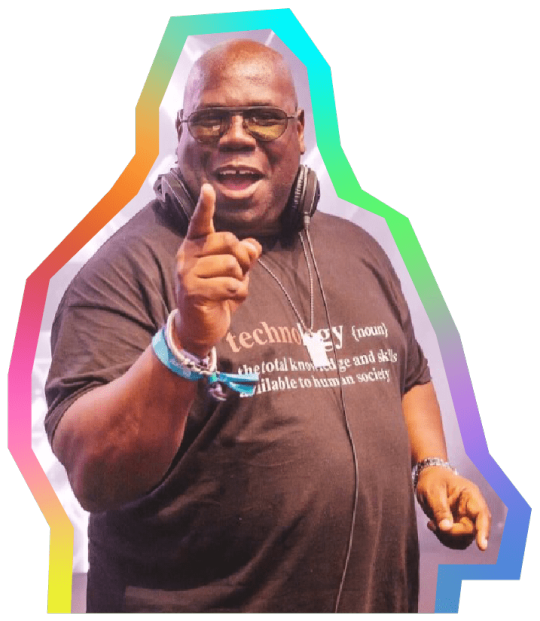
Carl Cox
Carl Cox is a legend if there ever was one. This British house and techno producer got his start at 15 working as a mobile DJ. Within a short time he was already well known for his uncommon talent of three-deck mixing.
Even when the music scene shifted over the years, Cox retained his techno sound, continuing to refine it and revive it in his own way. "Techno drives home somewhere," Carl Cox says. "It takes you to an element of surprise, not knowing where you're going. It's scary but wonderful at the same time."
After spending almost 40 years in the scene, Cox is still at it with an Ibiza residency and his own record label.
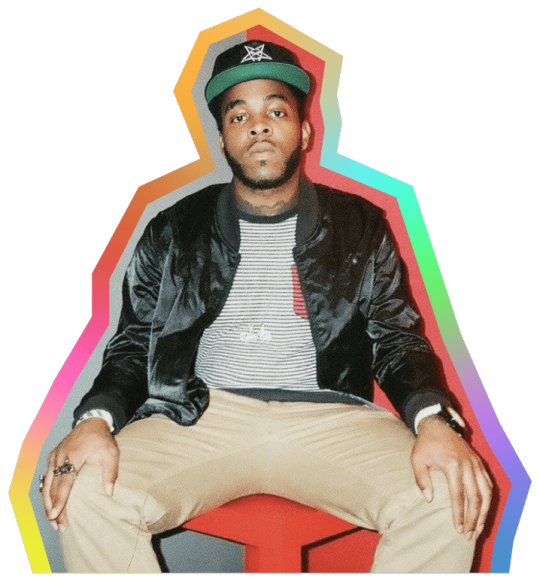
DJ Sliink
DJ Sliink is well-known in the Jersey club scene, a style of electronic music he describes as “this unique club music that’s for the inner city. I would describe it as clever, with vocal chops with a half beat, breaks from Baltimore, and crazy kicks.” Through Jersey club, Sliink met Skrillex who he collaborated with, even joining Skrillex’s label, OWSLA. But the collabs don’t stop there, check out Sliink collabing with Flosstradamus, Wale, Fetty Wap and Alexandar Smash, soundtracking Paris runway shows and spinning in London, Paris, Milan and Oslo.
If his high-energy blend of trap and hip-hop wasn’t hyphy enough, DJ Sliink takes his position in the scene one step further by being vocal about the lack of representation in the electronic music scene, calling on Spotify’s curator, Austin Kramer, to add more black artists to curated playlists and speaking out about racial inequality this week with Billboard.

Lotic
Lotic (J’Kerian Morgan) is another producer shaking up the scene — but this time, in Berlin. The Texas-born electronic artist is known for such tracks as “Hunted,” “Buy a Print,” and “Heterocetera.”
Lotic admits never really vibing with American culture, so after completing a degree in electronic music production at University of Texas, they moved to Berlin to find like-minded artists. But, as is the case with most visionaries, Lotic started bucking the normal club sound to create something more personal, vulnerable and new; especially as it relates to their identity as trans and black.
“Anything I’m afraid of I’m putting it on the record,” Lotic said in an interview with The Fader. “I did a lot of crazy emotional work in the process of writing.”
Visibility Matters
We’ve undoubtedly missed some of your favorite artists and failed to mention a number of amazing producers. Which is why we encourage you to let us know your favorite artists via Instagram, Twitter and Facebook. We’ll add your recommendations to our Kusheen playlist.
Finally, remember that the fight for black rights and against police brutality is ongoing. Use whatever means are in your power to combat white supremacy including (but not limited to) protesting, social media, calling your local politicians, voting, donating, supporting black-owned businesses, educating yourself, and of course — using the power of music to change hearts and mind.
Black Lives Matter. Black Dreams Matter. Black Visibility Matters.
0 notes
Text
Trump said he intends to declare antifa as a terrorist organization. Here's what we know about the decades-old, leaderless group.
The leaderless, non-hierarchial organization has existed for decades but has grown to greater prominence since Trump's election in 2016 and after the violent 2017 white supremacist rally and its counterprotests in Charlottesville, Virginia.
— By Michelle Mark and Connor Perrett | June 2, 2020 | Businesses Insider

Hundreds of protesters gather at Government Center including a protester with an antifa flag draped over his shoulders during a rally in support of the Black Lives Matter movement in Boston on May 31, 2020. Matthew J. Lee/The Boston Globe via Getty Images
President Donald Trump and other Republicans have blamed antifa, which stands for anti-fascist, for ongoing protests over the death of George Floyd.
The president said amid the protests that he intends to declare antifa as a terrorist organization.
The leaderless, non-hierarchial organization has existed for decades but has grown to greater prominence since Trump's election in 2016 and after the violent 2017 white supremacist rally and its counterprotests in Charlottesville, Virginia.
The group has represented a boogeyman of sorts for Trump, who previously threatened to classify the group as a terrorist organization in July 2019 after a clash between members of antifa and far-right group the Proud Boys.
Members of the group are known for clashing with members of the far-right and decrying white supremacy, though the group has drawn criticism in the past for its willingness to use violence.
President Donald Trump on Sunday announced plans to designate a left-wing group known as antifa as a "terrorist organization," blaming the group and other unidentified "radical left-wing" organizations for ongoing civil unrest following the death of 46-year-old George Floyd.
Floyd, a black man, died while in police custody on May 25. Video of the incident showed that a white police officer held his knee to Floyd's neck for more than eight minutes, even after Floyd lost consciousness. That officer, Derek Chauvin, was fired and charged with third-degree murder and manslaughter.
Three other Minneapolis police officers present have been fired but have not been charged with a crime.
Floyd's death has sparked protest — many peaceful but some violent — in Minneapolis and other major cities throughout the US, including New York, DC, Los Angeles, Chicago, and Atlanta. Over the past week, some protests have resulted in the looting of business, destruction of property, and death.
"I am your president of law and order and an ally of all peaceful protesters, but in recent days our nation has been gripped by professional anarchists, violent mobs, arsonists, looters, criminals, rioters, antifa, and others," Trump said at a June 1 press briefing.
Other Republican leaders joined Trump in claiming that protests are the result of antifa, a leaderless, non-hierarchial organization that has existed for decades.
Arkansas Sen. Tom Cotton called ongoing protests the work of "antifa terrorists" in a June 1 tweet, echoing the president's rhetoric. Republican Rep. Matt Gaetz similarly equated antifa with terrorists and said the members should be "hunt them down like we do those in the Middle East."
The group has represented a boogeyman of sorts for Trump, who in July 2019 similarly threatened to classify the group as a terrorist organization after a clash between members of antifa and far-right group the Proud Boys in Portland led to the assault of a conservative journalist.
While the group has existed for decades, its name seems to have entered mainstream vernacular after a white supremacist rally and counterprotests clashed in Charlottesville, Virginia in 2017. Trump was most likely referring to antifa activists when he blamed "many sides" for the violence in his initial statement on the Charlottesville violence. At a press conference later that week, Trump criticized what he called the "alt-left" for "charging with clubs."
In and around Portland, Oregon, activists with the organization smashed windows and hurled smoke bombs during a series of riots following Trump's election. In August last year, 13 people were arrested in a clash between members of antifa and far-right groups.
It's not exactly clear how many demonstrators at ongoing protests are members of antifa.
"The radical left is much bigger than antifa, much, much bigger, and the number of people who are participating in the property destruction are much, much bigger than the radical left," Mark Bray, a historian at Rutgers University who authored "Antifa: The Anti-Facist Handbook," told the Associated Press.
Here's what you need to know about the activist movement:
What is antifa?

A counterprotester with an antifa sign outside the Boston Commons and the Boston Free Speech Rally in Boston in 2017. Reuters/Stephanie Keith
Antifa, short for "anti-fascist," describes a decentralized, leaderless movement dedicated to combatting right-wing authoritarianism and white supremacy. It has existed for decades but gained prominence after the election of President Donald Trump in 2016, and has continued to be associated with clashes and protests since.
Its members include a mixture of anarchists, socialists, communists, and other far-left activists. It's unclear how many people count themselves as members, but local, autonomous chapters or cells exist in major cities across the US, in many cases accompanied by sizable online followings.
The movement's adherents reject the notion that white supremacy can be quashed by any government apparatus and believe it instead must be eradicated through direct action.
Bray said the group lacks hierarchical structure or universal set of tactics that would make it recognizable. Its members often to espouse revolutionary and anti-authoritarian views, he said.
Sometimes their action consists of traditional community-organizing efforts like peacefully protesting or fundraising. In other cases, Antifa activists have staged doxxing campaigns to expose suspected white supremacists to their employer or landlord and have sometimes used violence to clash with those they view as fascist.
Antifa activists believe that legislative efforts or action from law enforcement are not only insufficient in expunging racist or fascist viewpoints but perpetuate them.
These beliefs were put on full display during the Charlottesville, Virginia, rally, when counterprotesters complained that the police had neglected to protect them from violence. It was antifa, instead, that had physically defended vulnerable counterprotesters and prevented further bloodshed, they argue.
"The police didn't do anything in terms of protecting the people of the community, the clergy," Cornel West, a prominent academic and activist, told The Washington Post. "If it hadn't been for the anti-fascists protecting us from the neo-fascists, we would have been crushed like cockroaches."
The origins of antifa lie in subcultures that emerged to counter fascism in the 1900s.

Antifa protesters at a rally on June 4 in Portland, Oregon. Getty Images/Natalie Behring
Antifa's origins are sometimes attributed to European movements in the 1930s against Nazis in Germany and Blackshirts in Italy, though a more direct and contemporary ancestor of the movement would be the far-left activists who opposed British neo-Nazis in the 1970s and 1980s during the height of the punk-rock subculture's popularity.
In the US and Canada, the Anti-Racist Action Network sprang up around the same time in the 1980s in a similarly loose and decentralized state that Antifa exists in today.
America's oldest antifa group that still operates is Rose City Antifa, which formed in 2007 in Portland, Oregon, according to Bray.
Bray previously wrote in The Washington Post that these early Antifa adherents typically faced outright animosity from the mainstream left for their attention to what was then seen as fringe, racist groups instead of tackling "more large-scale, systemic injustices."
"Years before the alt-right even had a name, antifascists were spending thankless hours scouring seedy message boards and researching clandestine neo-Nazi gatherings," Bray wrote. "They were tracking those who planted the seeds of the death that we all witnessed in Charlottesville."
'You need violence in order to protect nonviolence': Antifa, in its members' own words

Anti-fascist counterprotesters outside Emancipation Park on August 12, 2017 in Charlottesville, Virginia. Getty Images/Chip Somodevilla
Antifa members don't hesitate to describe their movement as one that uses any means necessary to oppose fascism.
A 2017 manual for organizing local antifa groups published on It's Going Down, an Antifa-supporting journal, advises prospective members to stay anonymous, track and document "white nationalist, Far Right, and fascist activity," and organize demonstrations to counter events held by white nationalists or members of the so-called alt-right.
The manual warns against accepting "people who just want to fight," adding that "physically confronting and defending against fascists is a necessary part of anti-fascist work, but is not the only or even necessarily the most important part."
"No, I did not behave peacefully when I saw a thousand Nazis occupy a sizable American city," one activist wrote in a letter published on It's Going Down. "I fought them with the most persuasive instruments at hand, the way both my grandfathers did. I was maced, punched, kicked, and beaten with sticks, but I gave as good as I got, and usually better. Donald Trump says that 'there was violence on both sides.' Of course there was."
The necessity of violence in the face of what they perceive as a growing fascist threat is a sentiment expressed by many antifa adherents, who emphasize that white nationalists often cannot be reasoned with or otherwise opposed.
"You need violence in order to protect nonviolence," Emily Rose Nauert, an antifa member best known for being punched in the face by a white nationalist during a clash at Berkeley in April 2017, told The New York Times. "That's what's very obviously necessary right now. It's full-on war, basically."
Antifa's critics on the right have pushed back on the group's use of force

President Donald Trump makes a statement to the press in the Rose Garden about restoring "law and order" on June 1, 2020 in Washington, DC. Chip Somodevilla/Getty Images
Right-wing critics of antifa have long expressed concerns about the chilling effect the group has on their First Amendment rights. Conservatives have also decried the groups sometimes violent and confrontational tactics.
Conservatives have long complained of censorship and infringement on their freedom of speech — particularly on college campuses, where predominantly left-wing student bodies and faculties have often succeeded at shutting or shouting down controversial right-wing speakers and events.
Among the most prominent of such instances was Berkeley's cancellation of Ann Coulter's campus speech in 2017 out of fear that far-left activists and antifa members would respond with violence. The American Civil Liberties Union denounced the cancellation as a "heckler's veto," a legal term in which the government suppresses speech out of fear it will prompt a violent reaction.
In 2019, clashes between antifa members and far-right groups turned violent, leading to 13 arrests in August. In July, conservatives targeted the group after right-wing blogger Andy Ngo said he had been attacked by antifa members.
The GOP's yearslong calls for antifa to be labeled a terrorist organization have been amplified amid the ongoing protests surround Floyd's death and police brutality.
In statements about protests over Floyd's death , Attorney General William Barr described "antifa-like tactics" by out-of-state agitators and said antifa was instigating violence and engaging in "domestic terrorism."
The right-wing media has also fixated on the antifa movement, portraying it as an example of violence inherent in left-wing ideology. Fox News' Jesse Watters even attempted to confront a purported antifa member on the air — a stint that backfired when it emerged that the purported antifa member was really an 18-year-old YouTuber apparently pulling a prank.
Trump and his supporters have reacted to antifa violence with zeal, drawing parallels between the movement and the neo-Nazis and Ku Klux Klan members who antifa oppose.
Trump was possibly referring to antifa when he gave his now-infamous press conference at Trump Tower, during which he slammed what he called the alt-left — a term created by white nationalists that no actual left-wing group self-identifies under — as being equally to blame for violence in Charlottesville.
"What about the 'alt-left' that came charging at the, as you say, the 'alt-right'?" Trump said in 2017. "You had, you had a group on one side that was bad. And you had a group on the other side that was also very violent. And nobody wants to say that, but I'll say it right now."
The movement has sparked criticism, amusement, and discussion among the left.

A counterdemonstrator using a lighted spray can against a white nationalist demonstrator at the entrance to Lee Park in Charlottesville, Virginia, on August 12, 2017. Associated Press/Steve Helber
Liberals have generally been slow to acknowledge antifa. While some have lamented the violence at recent protests, others have reacted with amusement at certain antifa antics.
"Their presence at a protest is intended to intimidate and dissuade racists, but the use of violent measures by some antifa against their adversaries can create a vicious, self-defeating cycle of attacks, counter-attacks and blame," the Anti-Defamation League said of antifa. "This is why most established civil rights organizations criticize antifa tactics as dangerous and counterproductive."
One of the most-witnessed instances of antifa violence came on Trump's January 2017 Inauguration Day, when an activist punched avowed white nationalist Richard Spencer in the face as he was giving an interview. A video clip of the encounter immediately went viral, to the cheers of prominent mainstream liberals.
The incident and its viral response prompted a debate over whether it's moral to "punch a Nazi" and whether broad acceptance of that behavior could increase ambiguity over which people can be accurately described as Nazis and who has the right to decide.
"No, it's not OK to punch a Nazi," Brian Levin, the directer of the Center for the Study of Hate & Extremism at California State University at San Bernardino, told CNN. "If white nationalists are sophisticated at anything, it's the ability to try to grasp some kind of moral high ground when they have no other opportunity, and that's provided when they appear to be violently victimized."
Levin continued: "That's the only moral thread that they can hang their hats on. And we're stupid if we give them that opportunity."
0 notes
Text
Day With(out) Art, the program

Amoqa is proud to partner with Visual AIDS for the thirtieth annual Day With(out) Art by presenting STILL BEGINNING, a program of seven newly commissioned videos responding to the ongoing HIV/AIDS epidemic by Shanti Avirgan, Nguyen Tan Hoang, Carl George, Viva Ruiz, Iman Shervington, Jack Waters/Victor F.M. Torres, and Derrick Woods-Morrow.
Shanti Avirgan, Beat Goes On
Beat Goes On is an impressionistic portrait of the activist Keith Cylar (1958–2004), co-founder of Housing Works and a central figure in the AIDS Coalition To Unleash Power (ACT UP) NY. Cylar spoke clearly, frequently and with moral force about the struggles of people living with HIV/AIDS in New York City, many of whom were impoverished and struggling with multiple social and medical problems. His openness about his own drug use and the centrality of the fight against the criminalization of drugs for AIDS activism make Cylar's legacy especially resonant and relevant at this time. A fellow harm reduction activist recalls how "Keith moved from mixing with the government, to threatening the government, to beating the government—all in the space of five minutes." By resurfacing and weaving together archival media of Cylar's own words and actions, this video will endeavor to convey—in the space of about five minutes—some of the personal charisma, political savvy and fearlessness that characterized Cylar's advocacy.
Bio: Shanti Avirgan is a documentary producer and archival researcher. Her work related to the AIDS crisis includes the feature documentaries Pills Profits Protest (2004); Sex in an Epidemic (2009); Larry Kramer in Love & Anger (2015); 5B (2019) and a forthcoming film about the photographer Peter Hujar. She has worked with a number of organizations in Brazil and the US to create, archive and curate video about ongoing HIV/AIDS activism. Shanti has also worked as a producer for National Geographic's climate change TV series Years of Living Dangerously, and the feature documentaries The Yes Men Are Revolting (2014), Life, Animated (2016) and Agility (2020), about the anthropologist Esther Newton. She holds a BA in Latin American Studies and Anthropology from UT Austin, was a Fulbright Scholar in Brazil at the Federal University of Bahia, and has an MPhil in Anthropology from NYU, where she studied medical anthropology and documentary filmmaking.
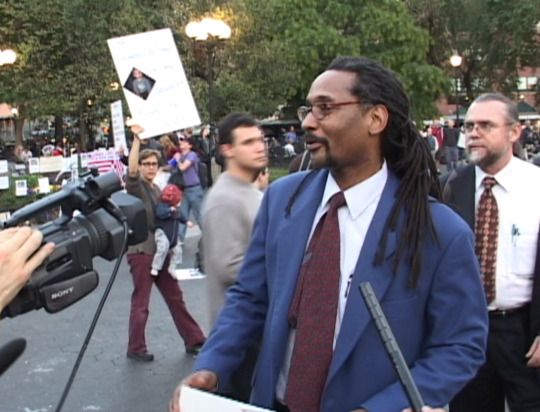
Shanti Avirgan, Beat Goes On, 2019. Commissioned for Visual AIDS’ Day With(out) Art 2019. Still courtesy of the artist
Carl George, The Lie
The Lie is the latest in an ongoing series of short films drawing on found footage and materials from the artist’s archive. Offering “ruminations on ruined nations,” the film aims to expose the links between war, AIDS, capitalism, and the persistent mythologies that bind them all.
Bio: Carl George is an artist and activist working in experimental film, painting and collage. His short experimental films have shown in festivals internationally and are in the permanent collections of the Museum of Modern Art, the Whitney, the Guggenheim Museum and the New York Public Library. His 1989 film DHPG Mon Amour, documenting the radical advances made by people with AIDS in developing their own health care, is a classic of AIDS activist filmmaking and was incorporated into the Oscar-nominated documentary How to Survive a Plague (2012). His visual art can be seen on the Visual AIDS Artist Registry.

Carl George, The Lie, 2019. Commissioned for Visual AIDS’ Day With(out) Art 2019. Still courtesy of the artist
Nguyen Tan Hoang, I Remember Dancing
I Remember Dancing brings together an intergenerational cast of trans and queer gaysians ruminating on the past and future of AIDS, activism, gay culture, love, and (un)safe sex. Inspired by Joe Brainard’s I Remember poems, these confessions illuminate perspectives of queer Asian communities often absent from whitewashed narratives of HIV and AIDS. Grief, regret, longing, risk, and pleasure surface as their memories and fantasies blur into one another.
Bio: Nguyen Tan Hoang is a videomaker and film and media scholar. His short experimental videos include K.I.P, Forever Bottom!, PIRATED! and look_im_azn. He is the author of A View from the Bottom: Asian American Masculinity and Sexual Representation (Duke UP, 2014) and articles on porn pedagogy and Southeast Asian queer cinema. He teaches literature, film, and cultural studies at UC San Diego.

Nguyen Tan Hoang, I Remember Dancing, 2019. Commissioned for Visual AIDS’ Day With(out) Art 2019. Still courtesy of the artist
Viva Ruiz, Chloe Dzubilo: There is a Transolution
Viva Ruiz invites transgender AIDS activist, artist, and beloved friend Chloe Dzubilo (1960–2011) to speak via never before seen Hi-8 footage filmed by Chloe's then-partner Kelly McGowan. The process triangulates mother (Chloe), lover (Kelly), and child (Viva) in a deliberate ritual to uplift the spirit and legacy of an ancestral teacher. Through artifacts from the moment when video first became accessible and before mobile phone cameras became ubiquitous, we witness Chloe declare herself and her sisters as leaders in art, advocacy and culture for evermore.
Bio: Viva Ruiz is the daughter of Ecuadorian immigrants and a community and nightlife-educated advocate and artist born and based in New York City. The throughline of her work across mediums is a passion to dismantle white supremacy and exorcise the colonial/colonized mindset. In 2017, she programmed sex education and practical spirituality workshops as an invited curator for the New Museum’s "Scamming the Patriarchy" youth summit. Her 2019 solo exhibition “ProAbortion Shakira: A Thank God For Abortion Introspective” at PARTICIPANT, INC included work related to the multimedia abortion de-stigmatization experiment THANK GOD FOR ABORTION.

Viva Ruiz, Chloe Dzubilo: There is a Transolution, 2019. Commissioned for Visual AIDS’ Day With(out) Art 2019. Still courtesy of the artist
Iman Shervington, I’m Still Me
I'm Still Me explores how digital platforms have created community and connections for Sian, a Black woman living with HIV and navigating the stigma and misinformation that is prevalent in the American South. Through her blog, social media accounts and online video platforms, Sian connects with (predominately) heterosexual Black women that send her messages, ask questions, and share their experiences with stigma and fear, all the while creating community that may have previously only existed in the shadows.
Bio: Iman Shervington is the Director of Media & Communications at the Institute of Women & Ethnic Studies (IWES), a public health non-profit. Through IWES, Iman has utilized her script development, cinematography, directing, producing, and editing skills to create over 50 short films and PSAs, a web-series, a feature-length documentary, two feature-length narrative films and an award-winning podcast. In 2016, Iman was chosen as a Robert Wood Johnson Foundation Culture of Health Leader to promote a culture of health in New Orleans and she received the award as a "Changemaker" in the New Orleans-based Millennial Awards. Outside of film, Iman specializes in social marketing, social media management, graphic design, photography, positive youth development, participatory action research, and media literacy.

Iman Shervington, I'm Still Me, 2019. Commissioned for Visual AIDS’ Day With(out) Art 2019. Still courtesy of the artist
Jack Waters/Victor F.M. Torres, (eye, virus)
Through an experimental collage of video and pictographs, (eye, virus) explores how conversations around disclosure, stigma, and harm reduction shift across generations and from public to private realms. Combining street interviews with footage from a punk show and a mobile testing site, the video centers pleasure and community as it expands the conversation around HIV to include hepatitis C and the opioid epidemic. (eye, virus) extends from documentation of a 2017 public program titled AIDS OS Y Version 10.11.6, and is collaboratively produced with Nikki Sweet.
Bio: Jack Waters is a visual artist, film maker, writer, media artist, choreographer and performer. Jack’s work has been shown at the Museum of Modern Art, the New Museum, the New York and London Film Makers Cooperatives, Center for Contemporary Culture Barcelona, and Anthology Film Archives. With his partner Peter Cramer, Jack co-directed ABC No Rio from 1983–1991 and founded the non-profit arts umbrella Allied Productions, Inc., as well as the community art garden Le Petit Versailles. The first part of Jack’s musical opus Pestilence will premiere at LaMaMa Experimental Theater Club in Spring 2020. His visual art can be seen on the Visual AIDS Artist Registry.
Victor F. M. Torres is an intermedia artist born in Rio de Janeiro, Brazil, currently living in Brooklyn, NY. Torres holds an MFA in Intermedia and Digital Arts and a BA in Socio-Cultural Anthropology, both from the University of Maryland, Baltimore County. He is an Adjunct Faculty at John Jay College of Criminal Justice, CUNY. Torres has taught at the Maryland Institute College of Art, Stevenson University, George Mason University, and UMBC. He is the author of Language Writes Myth Writes Reality: Or How Does the Acculturated Body Take the Role of Culture Maker?. Torres’ sculptural work snapshots the relationship between information retention, capacitive touch, and bronze age aesthetics, thinning the threshold between primitivism and futurism. His work has been shown at the Museum of Modern Art, Baltimore Museum of Art, Monmouth Museum, MIX NYC, Maryland Art Place, and Grace Exhibition Space, among others.
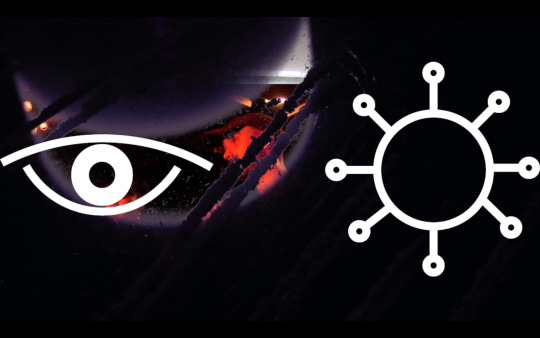
Jack Waters/Victor F.M. Torres, (eye, virus), 2019. Commissioned for Visual AIDS’ Day With(out) Art 2019. Still courtesy of the artists
Derrick Woods-Morrow, Much handled things are always soft (8:36)
Much handled things are always soft unearths the unwritten and undocumented histories of public sex culture in the south-side of Chicago. Through conversation with longterm survivor Patric McCoy, the film traces the height of activity in the 1970s, the downfall of cruising culture in the 1980s, and the prevailing summer heat, which continues to linger. Together, McCoy and Woods-Morrow reflect on their relationship to cruising, to photography, and to each other; attempting to bridge the gap between what was, and what still remains to be explored.
Bio: Derrick Woods-Morrow’s work is a meditation on deviation and disruption. Currently based in Chicago, his artistic practice deploys a wide variety of media, including photographic transfers, digital video collage, ceramics, and narrative performance. Exploring modes of representation, he salvages, displaces, and removes raw material from sites of historical significance and trauma, reimagines their future purpose and denies their perceived function, while actively interrogating the correlation between labor and play. A recipient of the 2018 Artadia Award, Derrick received his MFA in Photography from the School of Art Institute of Chicago in 2016, and was most recently an Adjunct Assistant Professor of Photography and Teaching Artist at the University of Illinois Chicago. His work appeared in the 2019 Whitney Biennial, in collaboration with Paul Mpagi Sepuya and his recent works were shown at YNCI V: Detroit Art Week Expo, in a solo exhibition curated by Darryl Terrell.
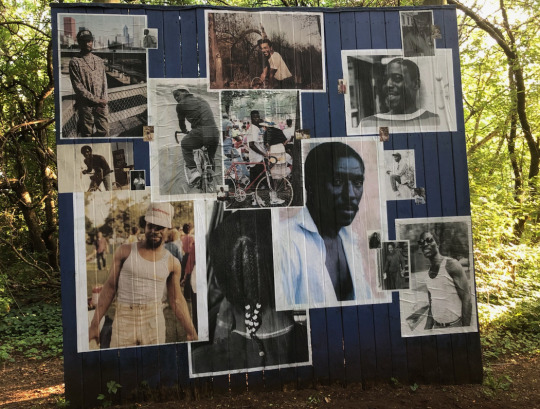
Derrick Woods-Morrow, Much handled things are always soft, 2019. Commissioned for Visual AIDS’ Day With(out) Art 2019. Production still by Patric McCoy
0 notes
Text
REPORT BACK: NYU PROTESTERS SHUT DOWN GAVIN MCINNES AS PROUD BOYS ‘SEIG-HEIL’

February 3, 2017 | It’s Going Down
On the night of Thursday February 2nd, I walked with two fellow graduate students over to NYU’s Kimmel Center where Gavin McInnes, co-founder of Vice and leader of the alt-right hipster Nazis called the Proud Boys, was scheduled to speak at an event organized by NYU College Republicans and sanctioned by the university administration. The previous night, antifascists shut down a Milo speech at UC Berkeley, setting fires, throwing barricades and fireworks into the building where he was supposed to speak, and even smashing up a Starbucks. Gavin’s Proud Boys previously served as a security force at the alt-right “Daddy Will Save Us” art show, so we were prepared for a violent confrontation with fascists. Still, we wondered if he would even show his face. In December, McInnes threatened to crash a punk show in Brooklyn with his Proud Boys, but in the end, a large contingent of antifa defended the venue and none of the Proud Boys showed up.
Then, suddenly, there he was with his ridiculous hipster mustache and a gaggle of Proud Boys, many wearing MAGA hats, all singing some dumb hymn. A huge police presence protected the Proud Boys from protesters, but some of them got shoved anyway and we yelled at them, calling them Nazi scum. We went inside the building, while the Proud Boys who accompanied Gavin on his march to campus were kept outside by campus security, since they were not NYU students and did not have IDs. As we took the elevator up to the tenth floor, where the speech was taking place, we were confronted both by a liberal, who told us, “Violence is never the answer” and a Trump supporter, who called antifa cowards because they wear masks. Of course, he waited until he was sitting at a table with other Trumpists to put on his MAGA hat. We waited for about a half hour in line to get into the room where the event was taking place. MAGA-hatted Trump supporters made up a small minority. Most of the students who were there came to protest.
Get your Latest News From The Leftist Front on LeftPress.tk → Help Us Gather News (Click for Details) ←
Gavin McInnes arrived on stage to a chorus of boos. He semi-ironically began his speech by saying he came to discuss the Jew, the black and the Mexican. Beneath his ironic exterior, we knew that his rhetoric about political correctness is only a cover for white supremacy. NYC Antifa reported on Twitter that outside, Proud Boys “sieg heiled the crowd while protected by police.” Protesters continually heckled McInnes as he rambled incoherently about Margaret Thatcher and Argentina. He then told the crowd that he was pepper sprayed with a water gun. “When I was sprayed I thought, ‘maybe it was acid,’ but then I remembered this isn’t Islam.” That was the breaking point. Many of our classmates and friends who are Muslim have been directly affected by Trump’s Islamophobic travel ban. Chants of “Fuck you” and “Whose campus? Our campus!” drowned out McInnes’s speech. The dean repeatedly took the mic from McInnes, telling protesters to quiet down because we need to “respect free speech.” We yelled at the dean too, telling him there is no free speech for Nazis. The last time this happened, McInnes said to the dean, “You are ridiculous sir. You are a dumb liberal asshole. You’re a beta male cuck.” That was it. The dean tolerated and even supported McInnes’s racist hate speech, but would not stand for his personal insult and humiliation. Security escorted McInnes out of the room.
We shut Gavin McInnes down Thursday night, but this is an ongoing battle that we will have to fight not just against Neo Nazis (however they choose to label themselves), but also against the police who protect them, and neoliberal institutions like NYU that invite them to spread their hateful message and recruit new members. It is worth noting that earlier on Thursday, NYU invited ICE agents to come speak to students at a job fair. Rather than face off against protesters, the ICE agents left the fair. NYU has so far refused to call themselves a “sanctuary campus,” even as administrators have sent emails pledging their support to immigrant and Muslim students. The events of Thursday proved how hollow this rhetoric is. Still, we can take inspiration from Thursday’s action, as NYU students and the New York City community came together to shut down the alt-right.
Related Stories on LeftPress:
► AND NOW…THE RESISTANCE!
► RESPONDING TO FASCIST ORGANIZING
► HOW TO CANCEL NEO-NAZI BAND, BLOOD & SUN SHOWS
26 notes
·
View notes
Text
Interview: Xiu Xiu
Jamie Stewart, lead singer and main songwriter of Xiu Xiu, is releasing the band’s tenth “main” album FORGET at the end of February via Polyvinyl. It’s one of their original song-oriented releases, as opposed to the more conceptual works such as their recent Twin Peaks interpretations or collaborative albums. Perversely catchy and decidedly upsetting, FORGET features an unusually wide array of guest contributors — 80s minimalist composer Charlemagne Palestine, LA Banjeeball commentator Enyce Smith, Swans guitarist Kristof Hahn, and punk singer/drag artist Vaginal Davis. As we spoke on the phone after an embarrassing timezone mix up on my part, Stewart started off by warning me that he’d been in a fight the night before. --- I apologize, I got punched in the head last night and I feel a little nauseous, so if for some reason I am just gone for a minute, then I’m rushing to the bathroom to throw up. But otherwise… What happened? If you don’t mind me asking. [laughs] You know, somebody named me just doesn’t like to keep his mouth shut about politics. That’ll bode well for this interview. Or badly, I don’t know, depending. Probably well. Anyway, I’m really sorry that happened to you. Oh, it’s OK. The other person is way more fucked up. Good. I’m assuming I’m on your side. Yes, you are. [laughs] Well, this first question might be on sort of the same topic. This new album is a pop album, it seems to me. You’ve been moving between the sort of conceptual ones and the pop ones recently, so I want to ask what does it mean to you to make these noise-pop albums specifically in this moment and this climate? Not that I would argue with you, but I don’t know if we really, at the moment, are thinking about this as a pop record. I think we’re going between thinking of things in terms of being as between conceptual records and song-oriented records. There’s not a tremendous distinction between the idea of pop and the idea of song, but if somebody’s unfamiliar with us, I don’t want to give them the idea that it’s going to sound like a Top 40 pop record. “Pop” is a little bit loaded. There’s been times in the past where we’ve very happily put one foot in the idea of being influenced by Top 40, but any song influences on this record didn’t have anything to do with that, although they have in the past. Currently, I would say that although they are very definitely melodic, verse/chorus kinds of music, they’re influenced by the history of songs and not pop so much. But, to answer your question, we started working on this before the dire fate of the world was revealed to us by the idiocy of the American populace, so it having anything to do with the current political climate insofar as the rise of white supremacy in the executive office isn’t the case. Is that what you were asking me? One cannot entirely ignore technical considerations like, “Is this in tune or not?” because from a craft perspective, one wants a song to be listenable, but at the same time, one cannot and should not ignore, “Does this feel real?” It doesn’t have to be about this current moment of white supremacy, although I think any answer will be inflected with that a little bit. I just want to ask, what is the context you see yourself writing these songs in? For me, they are, in a way, very communal. They bring a community together in some way, which seems something very specific to song traditions. I think of it differently than most of the records we have worked on, insofar as most of them we went in with a certain amount of conscious focus as to what the record was going to be. With this one, it very much just occurred, without any forethought. With the previous record, Angel Guts: Red Classroom, we had had a very, very definite and narrow vision of what we wanted that record to be about and how it would be made and what it would sound like. I like working under distinct constraints very much, and wanted to try to do that with this current record, but essentially we totally failed at it for almost a year-and-a-half. A long period of time went by with no progress made. And then we started to panic a little and realized that, OK, we have to make a record, even if we can’t decide on what the arbitrary constraints are going to be, so we just had to write and allow the goddess of music to determine what the songs were going to be and not think about a theme or whatever. They just emerged as they were going to emerge. I’m not trying to sound too flighty about this, but I don’t really remember working on them all that much. I think because we were trying to step out of the way, partially functionally, because it seemed to be working and the songs were occurring and they weren’t occurring before. And then that almost became the constraint of the record, essentially to have no constraint, which is not a thing we’d done for quite a long time. So, in coming back to your question, then, if there is any sort of communal basis for this record, it’s done completely out of our hands and in the hands of the muse, essentially. But I suppose that’s her job. This is obviously an album with a lot of collaborators on it, which is interesting, because it doesn’t feel that way. It feels very cohesive. So I wanted to ask how these folks were brought on. I’m particularly interested in the poem recorded by Vaginal Davis that closes out the album. For me, it’s very interesting the way it reframes the whole album. So, I’m interested in your thought process behind bringing these folks on. Were there any hopes as to what they would add to a given song or the record as a whole? A lot of people who are essentially heroes of mine are on the record. I really hoped that they would just be themselves. That’s one of the wonderful things about working with people who are extraordinarily experienced and brilliant, is that you don’t really have to have hopes for them or expectations at all. You know that what they will do, even if it’s different than what you would imagine it’s going to be, will be extraordinary. I kind of didn’t tell them to do anything, because one doesn’t need to. [laughs] They got to be who they are and where they are because they’re devoted to what they believe in artistically and what they believe in socially. As far as the process, it was really different with each person. With Vaginal Davis, it began when I was very, very young, barely a teenager. I was living in Los Angeles where I was born and currently live, and I came across this fanzine called “Band Is Dead,” and there was an article in there about Vaginal Davis’s band Black Fag. I had never seen anything before then that comprised queer politics, queer identity, genderfucking, a feminine display of masculine power, and punk rock all at the same time. She’s doing different things now, but at that time, through my very young-person lens, all of those things were what I needed to know and hear about and I’d never seen before, and suddenly I opened the zine and saw this one photo and read this one very short article and an entire world made sense to me. So, long story short, we eventually connected, when she put a drum stick up my butt on-stage. After that, I didn’t see her for very many years, and then I was doing a guest lecture at NYU and the professor, who’s a very close friend of hers, said, “Oh, you know my friend Vaginal Davis.” And I said, “Well, I kind of do because she stuck a drum stick in my ass.” And then he reconnected us, and last year, she and I, along with this German artist Sussane Sachsse, did a reworking of Mozart’s “The Magic Flute” at NYU together. At the same time, I’d been collecting images off this webpage called Backpage — Which was shut down, actually, today. Oh, really? Interesting. So, long story short, we eventually connected, when she put a drum stick up my butt on-stage. Like an hour ago. Well that was probably because it was notorious for trafficking underage sex workers. [Authors note: Children of the Night, a Los Angeles-based anti-trafficking organization, issued a statement against the closure, stating that it was taking away a critical tool for them to reach out to trafficked children, in addition to widespread outcry from sex workers of all stripes who view the closure as a threat to their livelihoods, bodily autonomy, and physical safety.] So, I had been, kind of as a social project, kind of out of curiosity, kind of just empathy, because a lot of this occurs not far from where I live, going through there and collecting photos of young women who were clearly women on the escort pages. And I had maybe 200 screenshots of these children. And then, after reporting it on the site, I would look at all these photos and I would write one line about my first impression of these young women. And that became this very, very long poem. And then while I was in New York working on this opera with Vaginal Davis, I edited it and made it a little more cohesive and asked Ms. Davis, who has this incredibly sonorous, beautiful speaking voice, if she would read the poem. And that makes up the end of that song. There’s another song on the record called “Petite,” which relates also to sex trafficking and underage women and just ideas of being overwhelmed by the evil of humanity general, so kind of the idea of being overwhelmed by the evil of humanity generally is a running thread through the record. It seemed to make sense to tie the end of the record together with that. Additionally, because it’s the 10th record and 10 is kind of a magic number, and because Vaginal Davis is a large beginning of my artistic and social consciousness, it made sense for her to participate in that. I do want to add, though, that even though this record is a very upsetting listen even by your standard, I find it almost celebratory in a way. With that poem at the end, there’s a certain sense of pride in her voice, as she lists a series of alternately silly, joyous, and devastating self-descriptions. They are people, and simply by being alive there’s a certain amount of celebration even in that. Even though at the moment their lives are probably extraordinarily miserable, that doesn’t mean that they always will be and that doesn’t mean that they have no point. As human beings, their lives are real. In horror and in tragedy, if someone persists at all — I mean, waking up every day, is resisting — what else are we to do with it, other than to celebrate it? This courage to continue to live. Do you feel like that is somewhat for you what this record, or what the process of making it or whatever, do you think that relates to it at all? In no way would I disagree with that assessment, but I would not have thought of it that way, if only because I’m always a little hesitant to posit an overarching theme to anything. I like that idea very much. Consciously or subconsciously, that’s certainly in there. It’s not the only thing it’s about, but I wouldn’t dispute that theme. It really is sequenced very classically in a way, the upbeat songs upfront and the long songs at the end. Perhaps that’s part of why it feel so inviting to me — in many ways it feels very familiar and lived in. A very close friend of mine — who is probably one of a very few friends of mine who actually listens to Xiu Xiu albums — mentioned that he listened to the last songs of all 10 original, regular Xiu Xiu records together, and said that they all seem to function in the exact same way. [laughs] He’s probably right. [Author’s note: Listen to a playlist of the last songs on the previous nine Xiu Xiu albums here, if you want to share in that experience] The quote-unquote confrontational or provocative aspects of your lyrics are obviously mentioned a lot, but I’ve always been fascinated by how your vocal style is at once very aggressive and very vulnerable. It’s almost a sort of confrontational vulnerability. How do you decide how to move between a whisper or a breath or a full-throated vocal or a shriek or whatever it is, to get to this place? Is it just instinct, or is there a technique? What does it look like for you when you start to approach the vocal section of these songs? Interesting question. Technically, I’m not a natural singer at all. I started taking singing lessons maybe a year-and-a-half ago, and I wish that I had started earlier because it makes it physically more tolerable to do. But it does require a tremendous amount of concentration and effort from me to do it, and I’m always extraordinarily nervous before beginning to record the singing. It hasn’t been consistent. It’s been really different at different periods. For the first four records, Cory McCulloch, who was an original Xiu Xiu member, produced all of the vocals, and I think I did almost all of them, with rare exceptions, with him in the room. And he and I had been incredibly close friends for many years. We’d seen each other at both our best and our worst, and because of that, he really pushed me to be as vulnerable as possible, and because I trusted him, it was easy to do. He would know if I was pretending, or if it could go further, and had me do it again. I wanted to go as far as possible, and I wanted it to be as real as it could be, so he was exactly the right person at the time to be doing it. And then for a long list of reasons, we had a bit of a falling out and haven’t worked together. Between the fifth record up until Angel Guts: Red Classroom, I had done all of them by myself, which was incredibly difficult. Trying to believe what you are doing but having no idea if it seems believable to somebody else, but not having someone there to tell you whether or not it is, is quite challenging. In the past, I could probably get through a song in two or three takes, but if I’m doing it myself, it usually takes between 10 and 20 takes to get it to the right place. It is fraught with doubt and uncertainty all along the way. I’m basically trying to get to the place where it is the most real and it is completely without thinking, the deepest and most subconscious and with the most pathos. For Angel Guts: Red Classroom, I was able to do them in the studio with John Congelton, and he’s somebody I’ve also known for many years and trust implicitly as well, and I was able to do them in three takes again. But for this last one, I decided to do it by myself in my little home studio again. It was a very, very long, difficult inward journey. Usually I can do one song in a day. It takes all day to do it. And then it requires a fair amount of editing afterward. Obviously, I feel a little tense about this. For me, it is the most important part of the record. It’s the part that puts across whether or not it has the potential to connect with someone. And I think because I attach so much importance to it, I enter into it with the most amount of tension and baggage. And considering the content of most of the songs, it’s usually a deep journey into something I feel fucking terribly about… It is certainly never fun to do. A lot of people who are essentially heroes of mine are on the record. I really hoped that they would just be themselves. That’s one of the wonderful things about working with people who are extraordinarily experienced and brilliant, is that you don’t really have to have hopes for them or expectations at all. The songs on the record, I think, speak to that. It’s interesting how the vocals, especially on a song-oriented album like this, are at once subservient to the song form at times and at other times quite aggressively break away. Considering that you do do a lot of vocal editing on these things, how do you decide what comes first? Is it always just prioritizing the most vulnerable or is it sometimes something else? It’s very difficult to decide. One cannot entirely ignore technical considerations like, “Is this in tune or not?” because from a craft perspective one wants a song to be listenable, but at the same time, one cannot and should not ignore, “Does this feel real?” It felt real at the time but does it feel real now? Similarly to playing, editing can and should be almost a subconscious quasi-meditative process, an intuitive process, as well. When one is playing, the goal is to be as removed from the physical and actual world as possible and just be inside of what’s happening artistically and spiritually and creatively and socially, and editing is not dissimilar from that. It requires the same amount of concentration. When you’re playing, you’re trying to listen to what is happening and respond to it; when you’re editing, you’re making similar kinds of choices, trying to determine whether or not what you are listening to feels like anything, and playing is the same kind of thing. Just because I’ve fucked around with Pro Tools all of my adult life, I can do at least the technical aspect without thinking now. Choosing aspects of a take and playing, it’s almost the exact same part of one’s brain and heart. And equally exhausting. Why is it so important for you to get here? Why do you want to get to this spot? Any record that has ever moved me, that’s where that record has come from. It’s in attempt to honor what those records have given to me as a listener and as a fan of music. Last question, what’s up with the pink-and-blue Arabic calligraphy cover? What’s the thought behind that? It’s pretty loaded. [laughs] Actually, we were trying to have it not be loaded. Although, boy. [laughs] We didn’t mean for it to be. Shayna [Dunkelman, Xiu Xiu member] and I played a show in Beirut this spring, and we had a wonderful time there. It was, I think, the last time that we played the Angel Guts set before we start playing the new record. So we thought, “Oh, this is the last place we’re going to be playing the last record, why not have there be some connections between beginnings and endings with the Arabic calligraphy?” And also, aesthetically, it’s beautiful. It’s the most beautiful writing in the world. It came out of sentimentality, essentially. We chose pink and blue because one cannot use white on black because of ISIS. From our normal standpoint, white on black would have been the way we would have done it, but obviously you’re not going to reference a death cult. We really just thought the pink and blue looked nice. We were trying to [be] depoliticized. I understand now that it is incredibly politically loaded, but our intent was to have it be something that we thought looked pretty and could be sentimental, and people could deal with it how they’re going to deal with it. That could be the title of your autobiography. [laughs] http://j.mp/2lklppT
1 note
·
View note